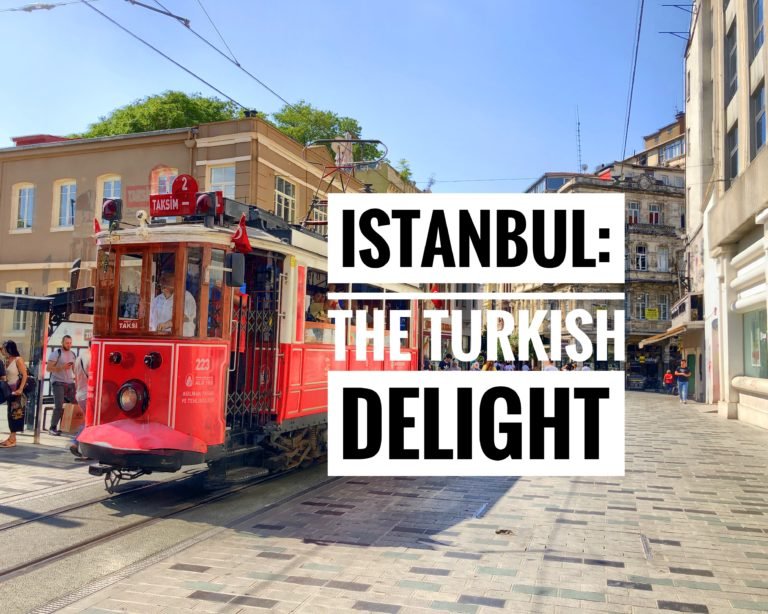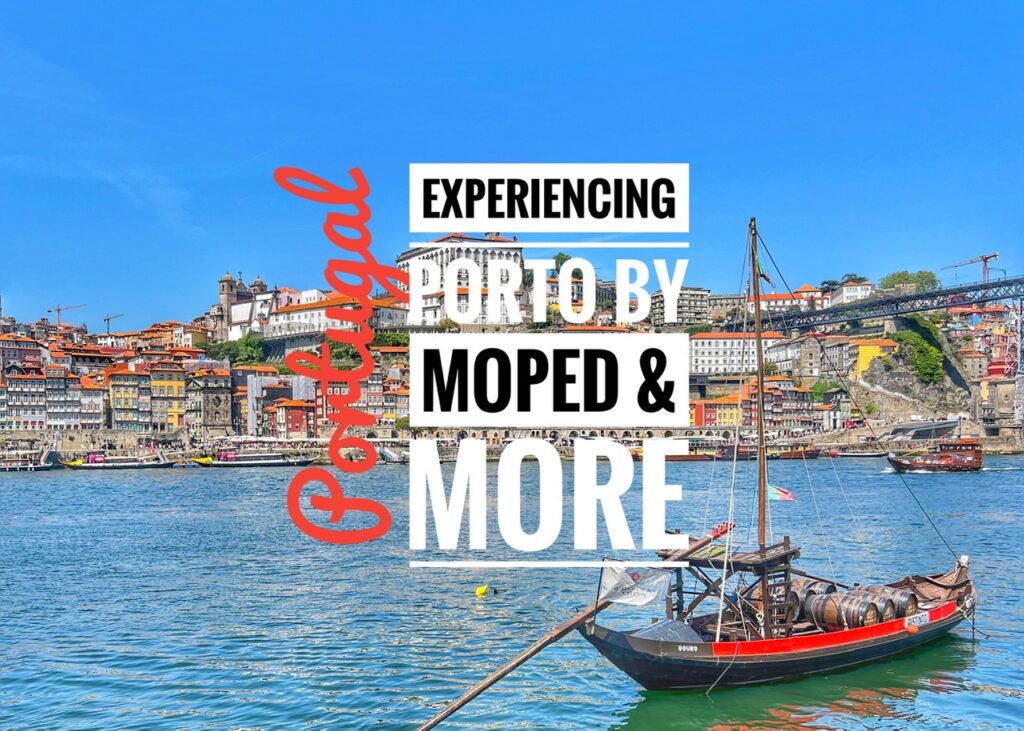
Porto is one of those cities that is dripping with European charm…red roof tops, contrasting sapphire blue waters, port wine flowing like water, and azulejos bedecking every other surface you encounter. It has a long and fascinating history as a port city, endless captivating colors and pedestrian thoroughfares dotting the spaces near the Douro River. It’s undoubtedly immensely walkable, and one of the most exceptional values in Western Europe. We don’t understand why so many flock to Lisbon when in fact, Portugal’s second city seemingly has so much more to offer.
Exploring by Moped
One small problem…we mentioned that Porto is immensely walkable. Well, since once of us is temporarily unable to use her right foot thanks to all kinds of issues which arose two months ago on Peru’s Salkantay Trek, we had to find alternatives. So….what to do when you can’t walk and gotta see the sites?! While we could have got a tuk tuk tour for an hour (25€) or an old fashioned car (100€!!), we opted to rent a moped for the entire day for 30€ and it was definitely the way to go despite the challenges with Mandy’s foot (it felt like packing up and remaining patient for a child ?.) Another challenge was the Google maps lady. She was being a bit of a bitch and sending us all over the place… Regardless, we managed to see many of the main sites in the center, checked out Vila Nova de Gaia and the fabulous views across the Douro River, and scootered up the coast for some beach time!
We rented the bike at Vieguini Bike Rentals, who also offered a half day rental for 25€, but that obviously isn’t a very good value in comparison. We had to book a day in advance, so make sure to do so, or you’ll be waiting in a very long queue for nothing. (At least during the current high season!)
Buzzing along the streets of Vila Nova de Gaia.
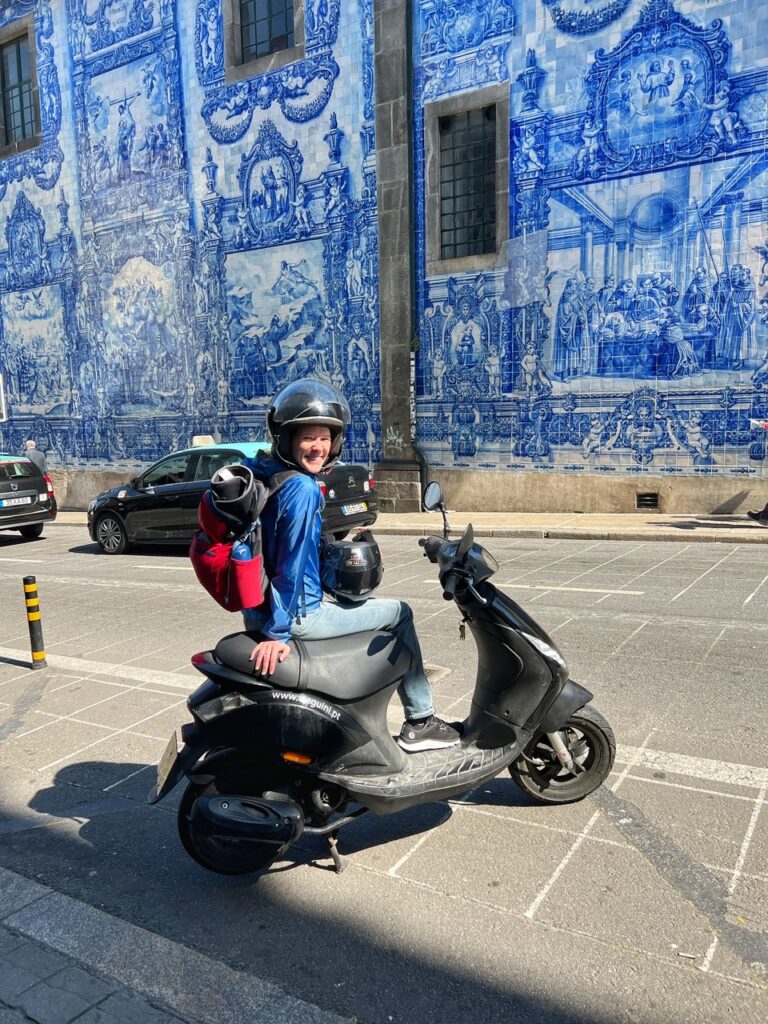
Mandy perched outside our first stop, the Chapel of Souls. She typically hung out at the scooter rather than booting up, which she carried in her backpack because it wouldn’t fit on the restricted brim of the scooter otherwise. While the princess sat on her chariot, this allowed Greg to be the photo slave and flit around. In reality, she was just elated to be out for the adventure!
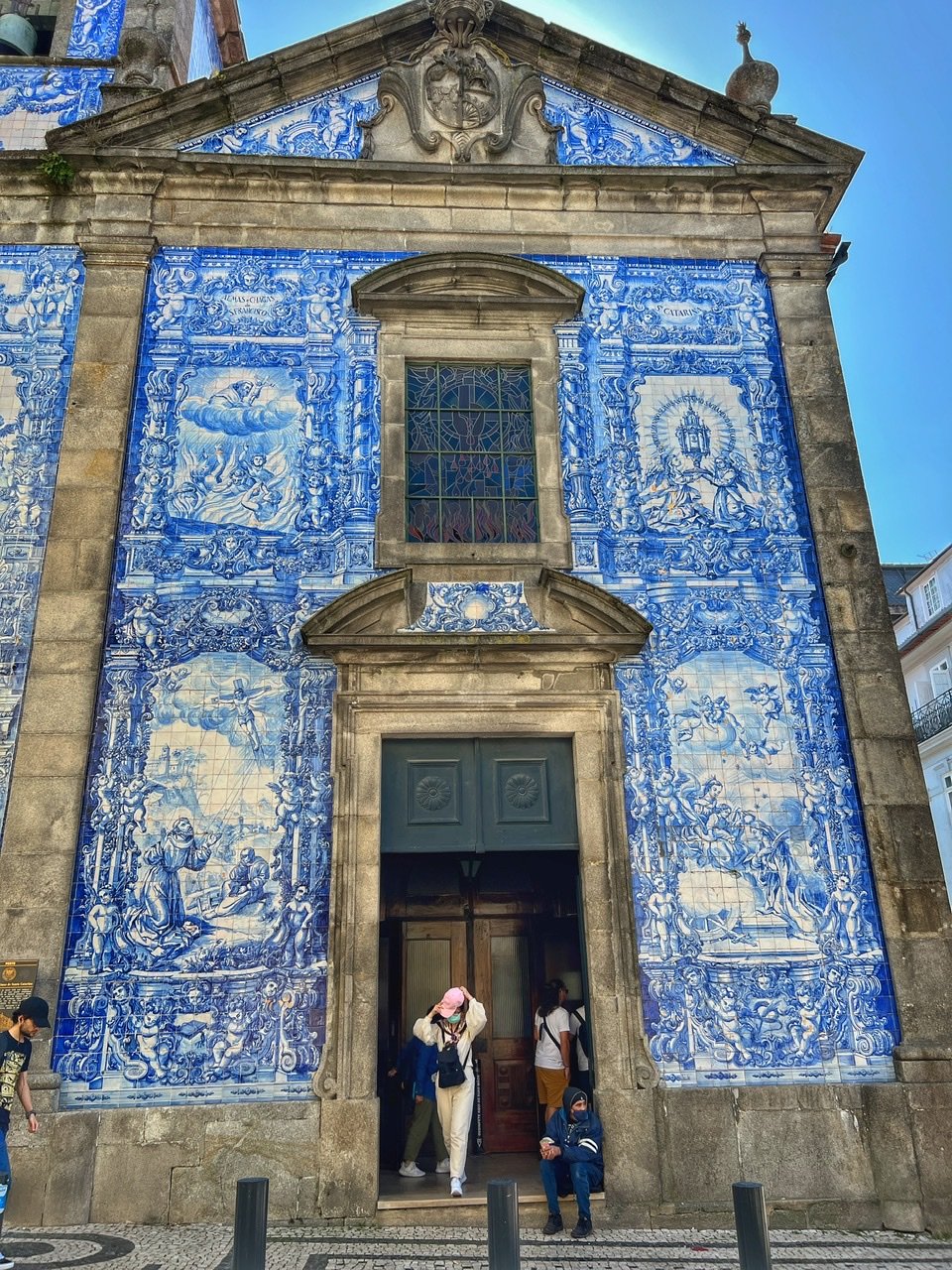
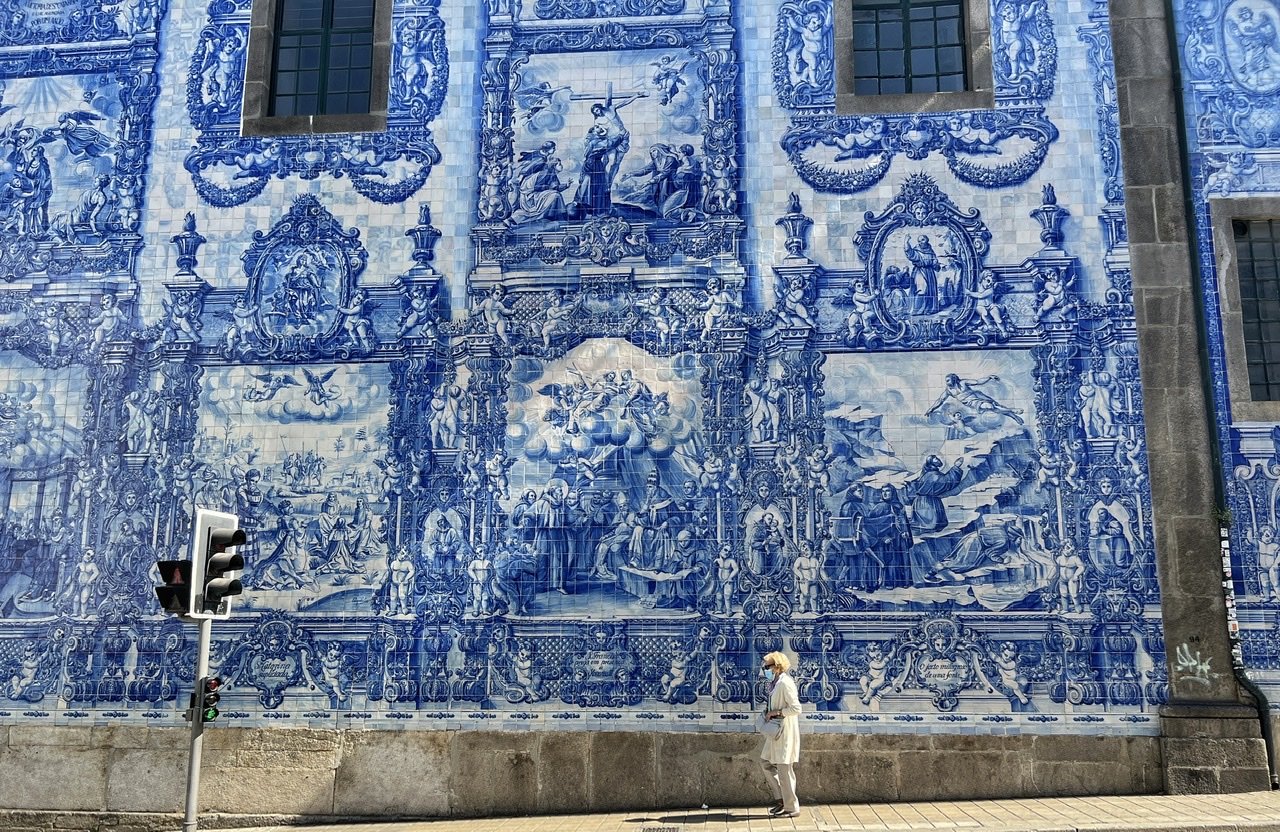
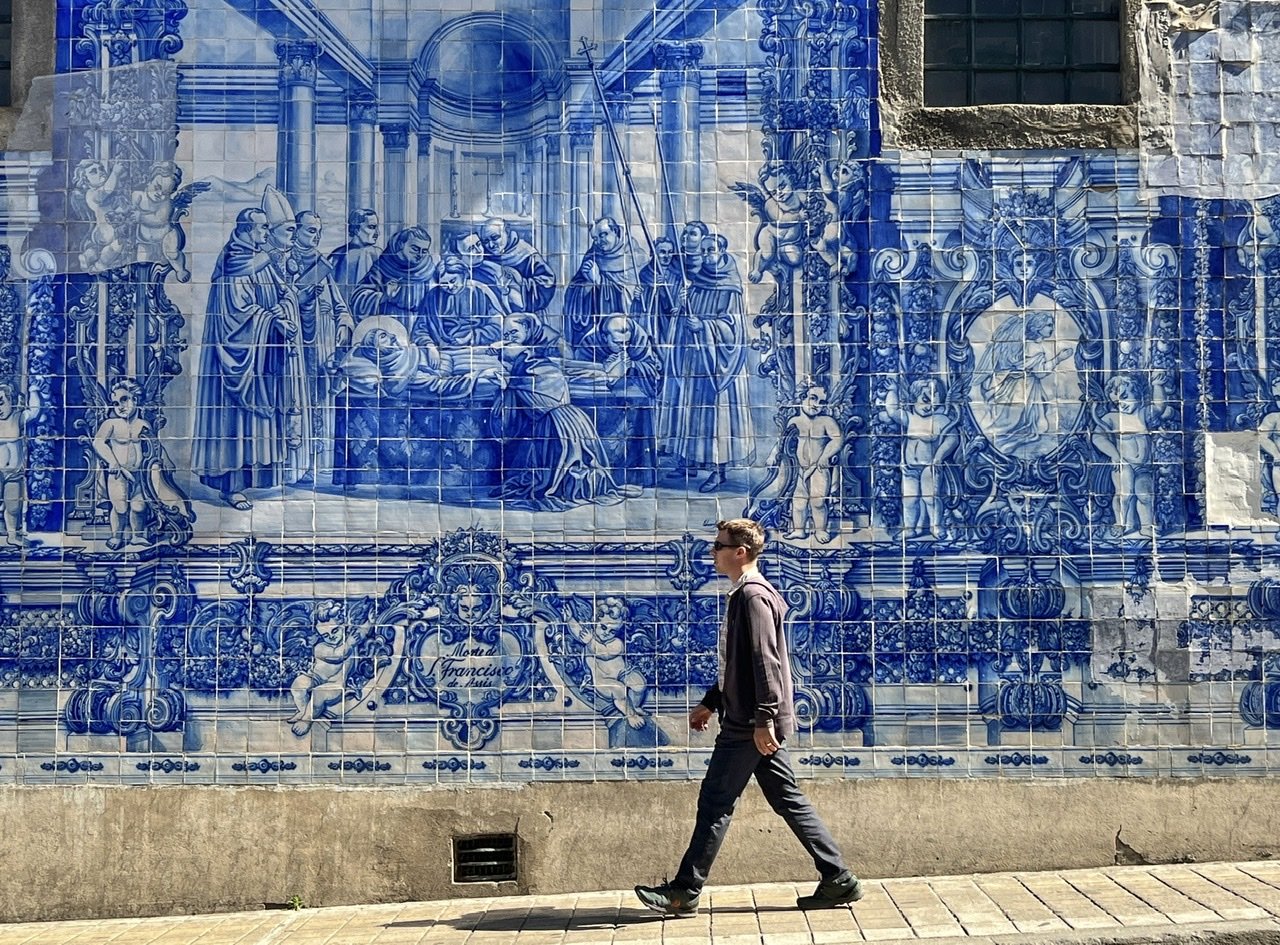
The Chapel of Souls is a tiny chapel dating from the early 18th Century. As you can see, it is blanketed in a superbly formulated puzzle of blue and white azulejos.
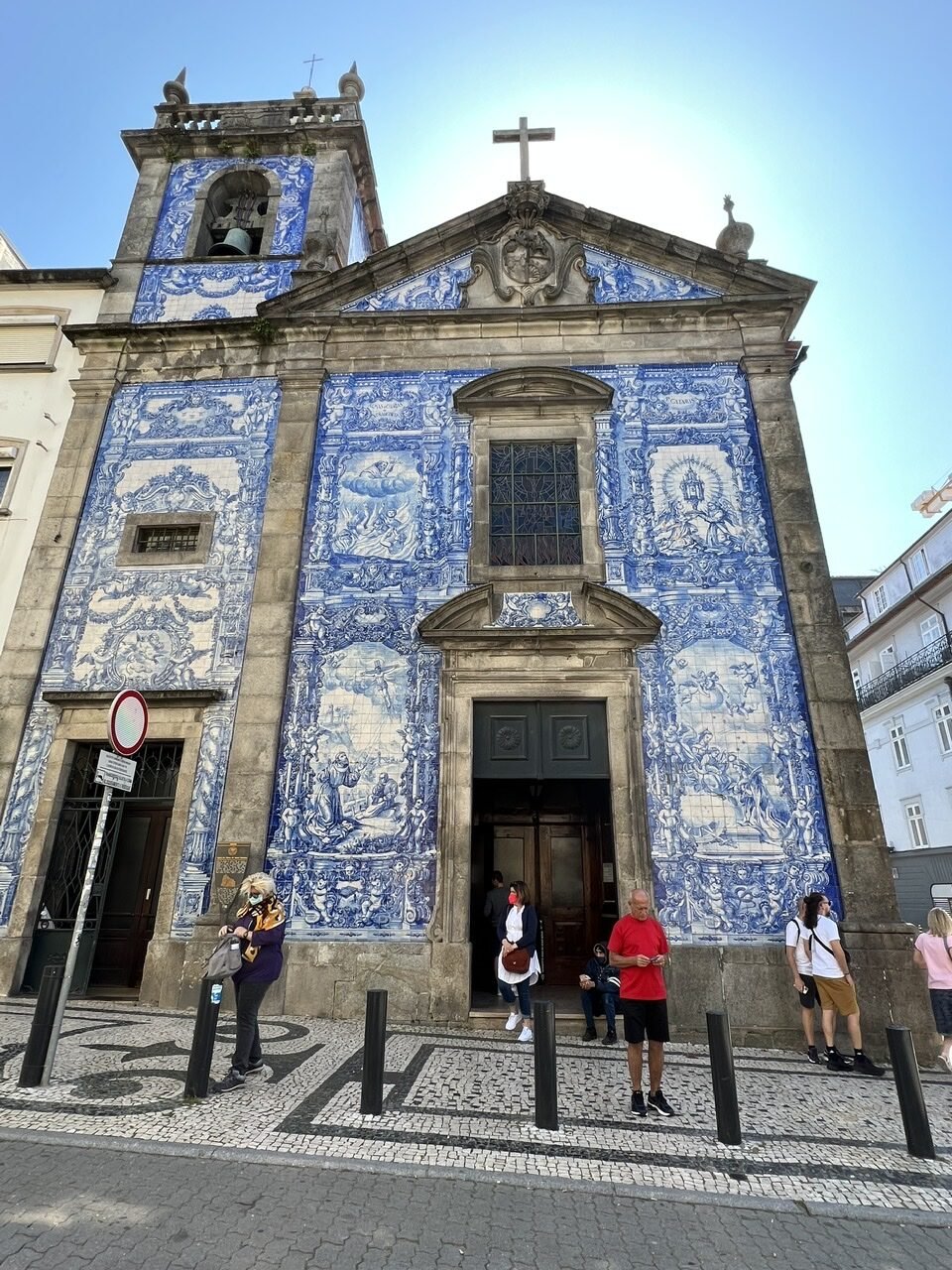
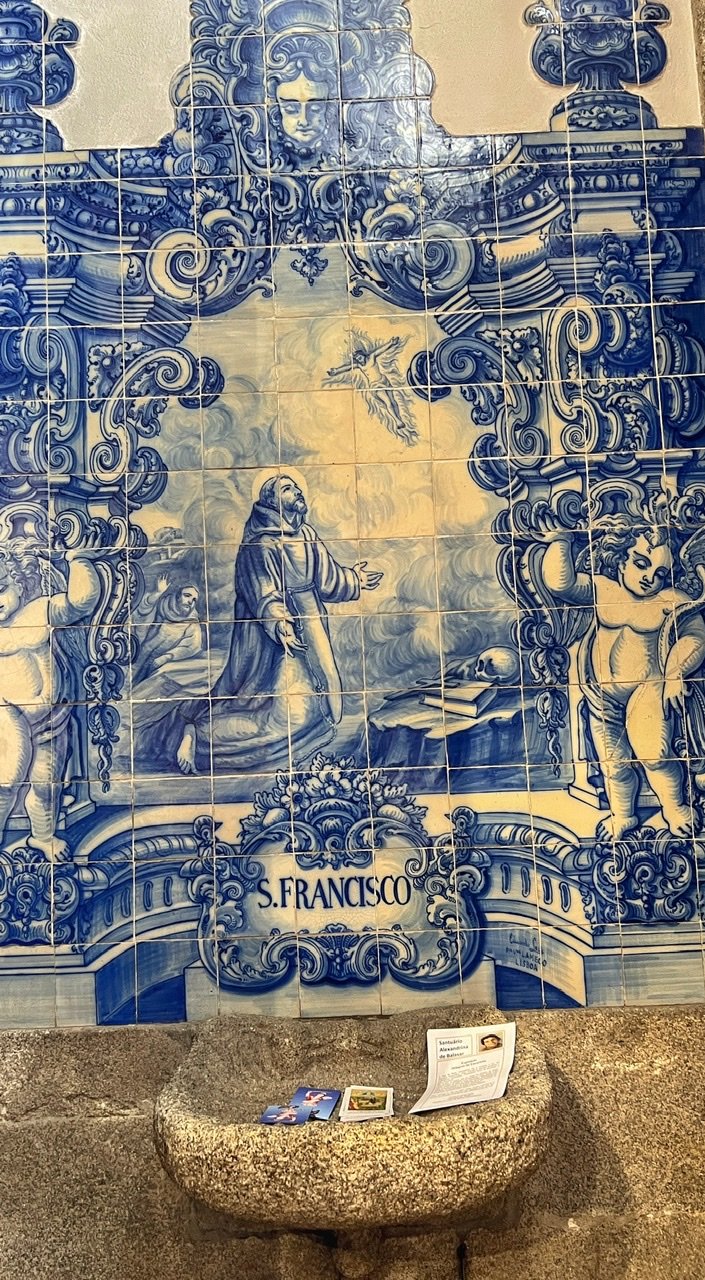
Azulejos=ceramic tiles. 16,000 of them evidently. Can you imagine the organization it must have required to put such a masterpiece together?! The tiles depict different religious stories and the lives of Saint Catherine and Saint Francis of Assisi, in particular.

The inside of Chapel of Souls seems a bit boring in comparison, although there are a few eye-catching tiles sprinkled throughout the interior.
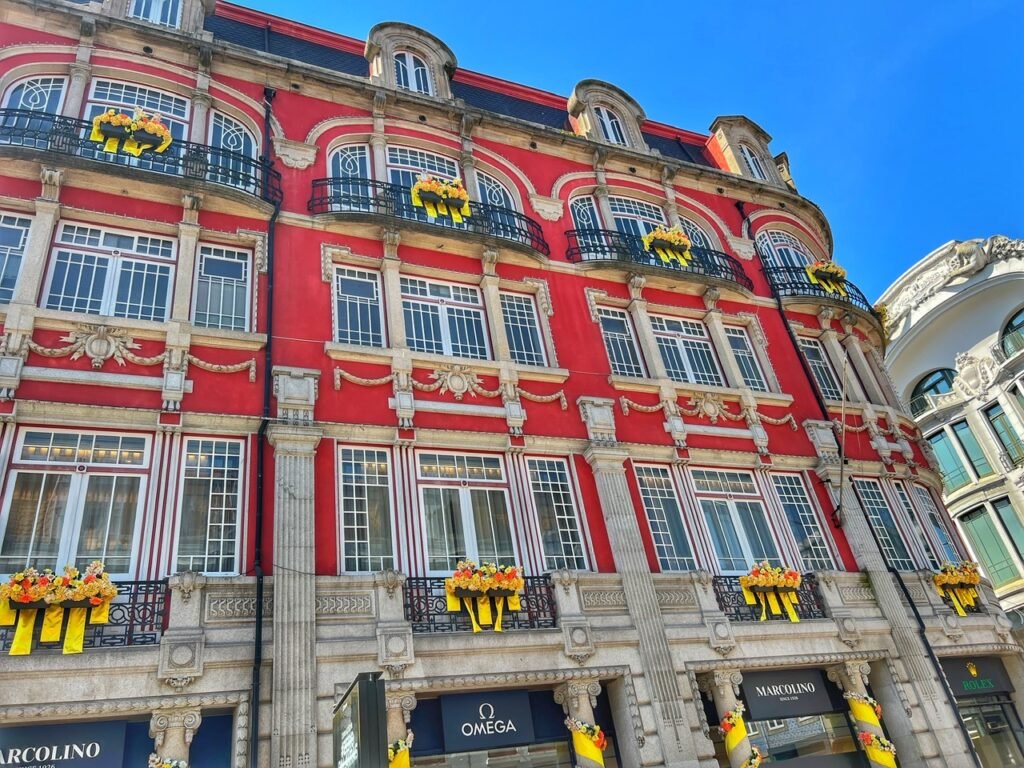
And if it’s not covered in gorgeous azulejos, you can bet it’s layered with brightly colored paint instead. We loved the architecture everywhere we looked!
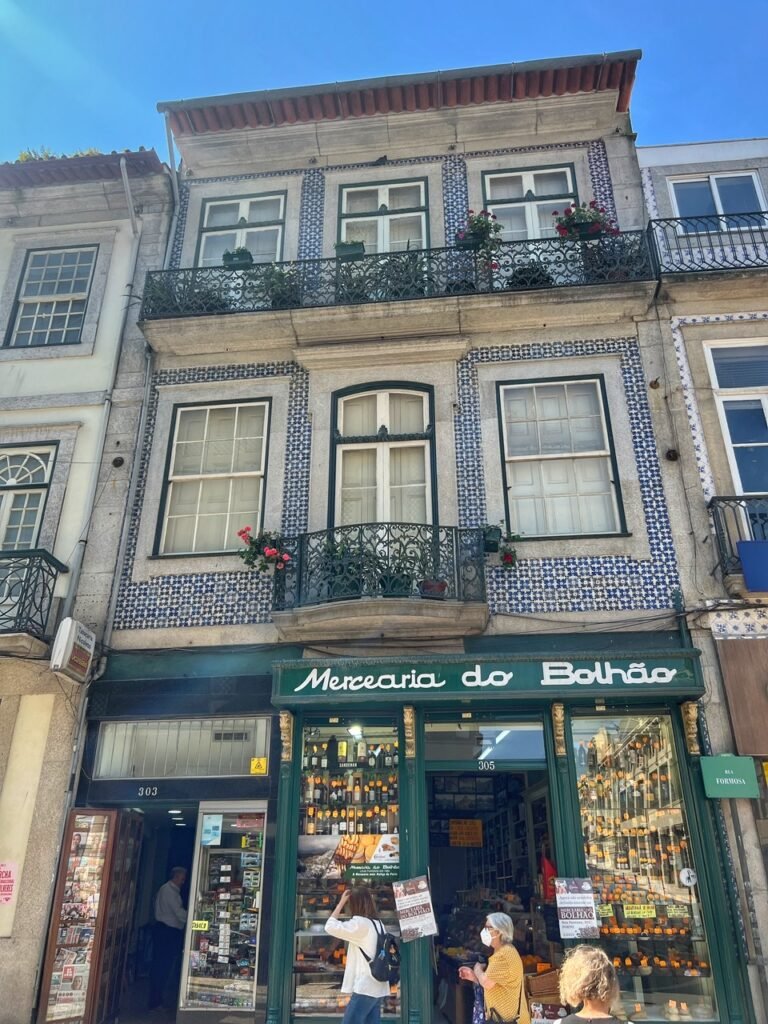
A typical azuelejo covered market selling Portuguese essentials like wine, cheese, sardines and bread. Speaking of sardines, move over tuna! They’re about a euro a can and are so delicious they’ve become our three times weekly fish of choice for salads, pasta and patties!
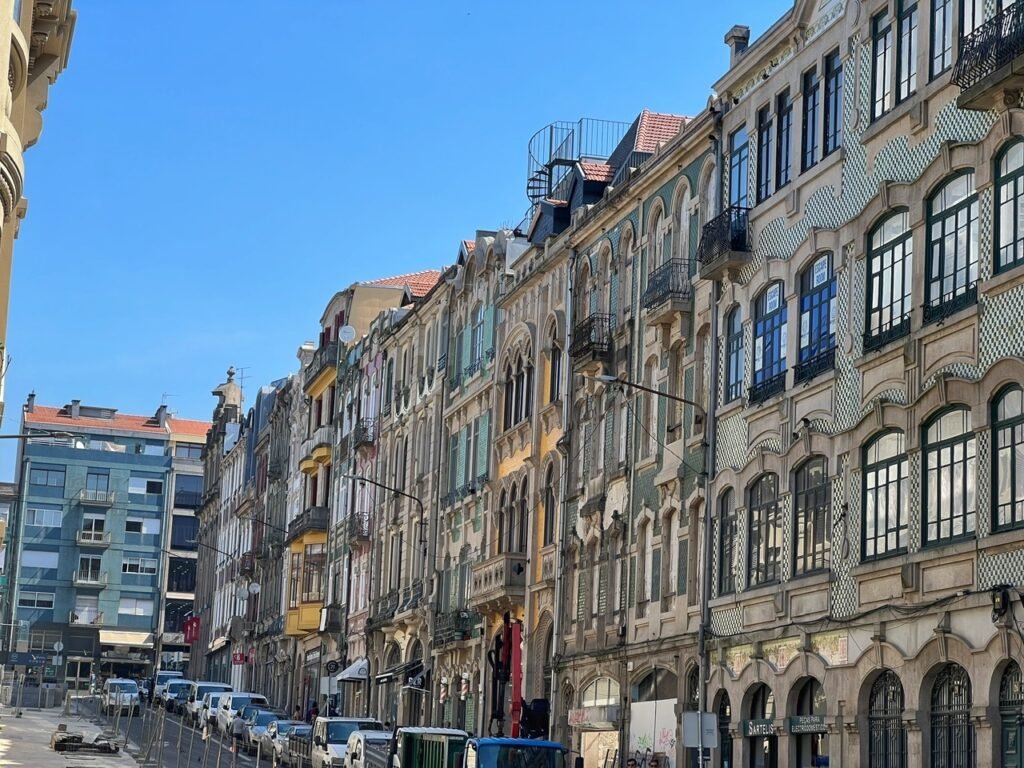
You really can’t beat buzzing around on a moped on these streets!
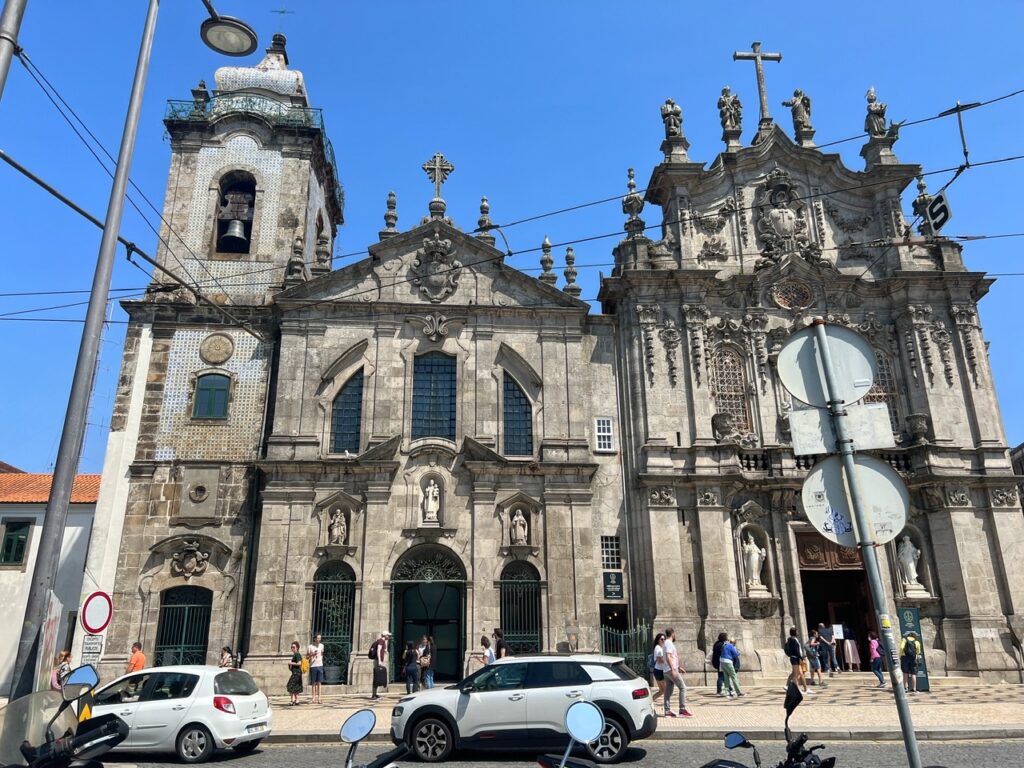
It seems like it would be impossible to count the number of churches in Porto. This one, Ingreja do Cormo, has stunning azulejos all covering its side similar to Chapel of Souls.
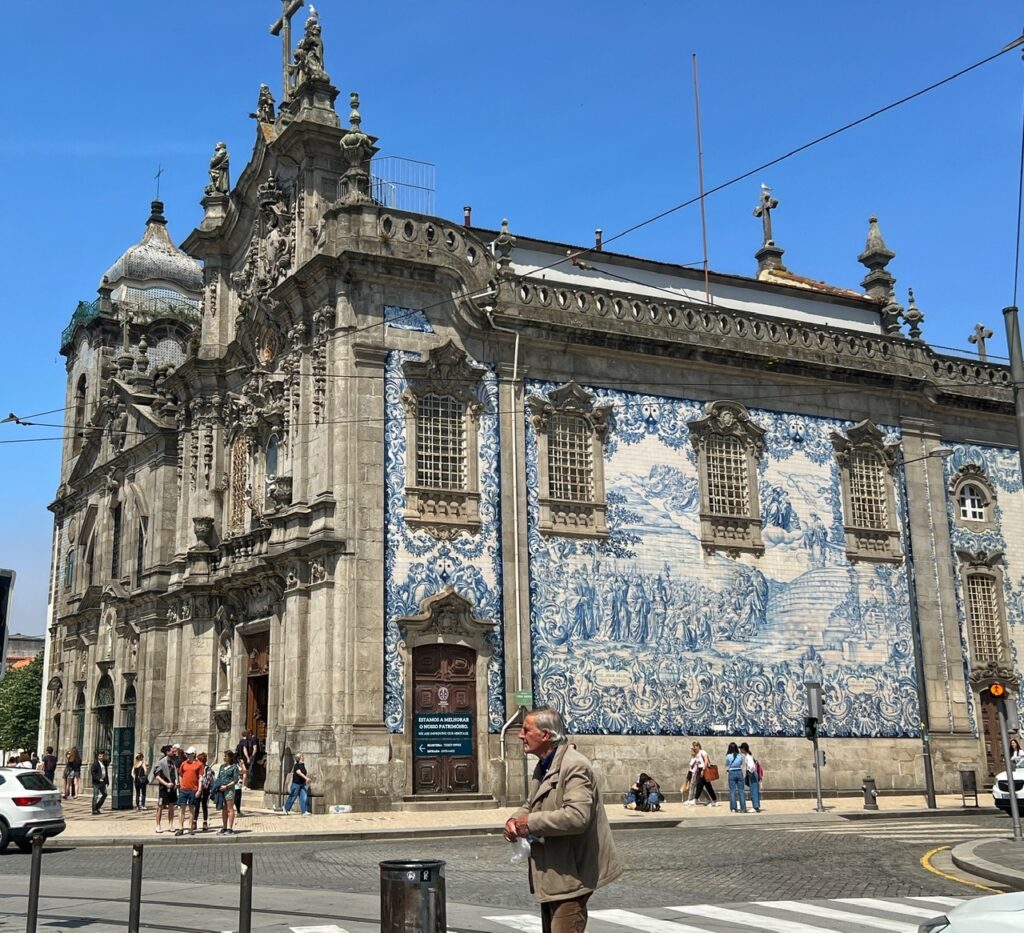
Apparently it also has catacombs in the bottom which you can check out for 3.50€.
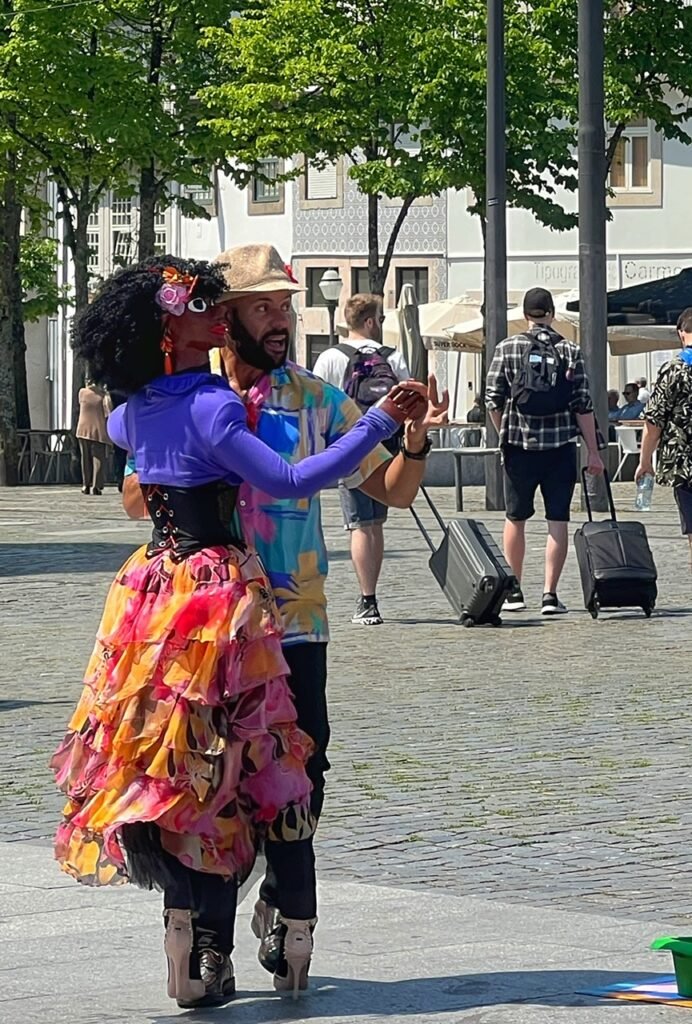
A street performer sashays with a very lovely lady…whose high heels were strapped semi-permanently to the toes of his shoes!! And look at those eyes! ? We’ve never seen this done before and were quite impressed with both of their dance skills!

Not sure what this Art Nouveau building is used for but the flashy peacock caught our lens.

Jardim de João Chagas, one of the many lovely parks we didn’t get to walk through!
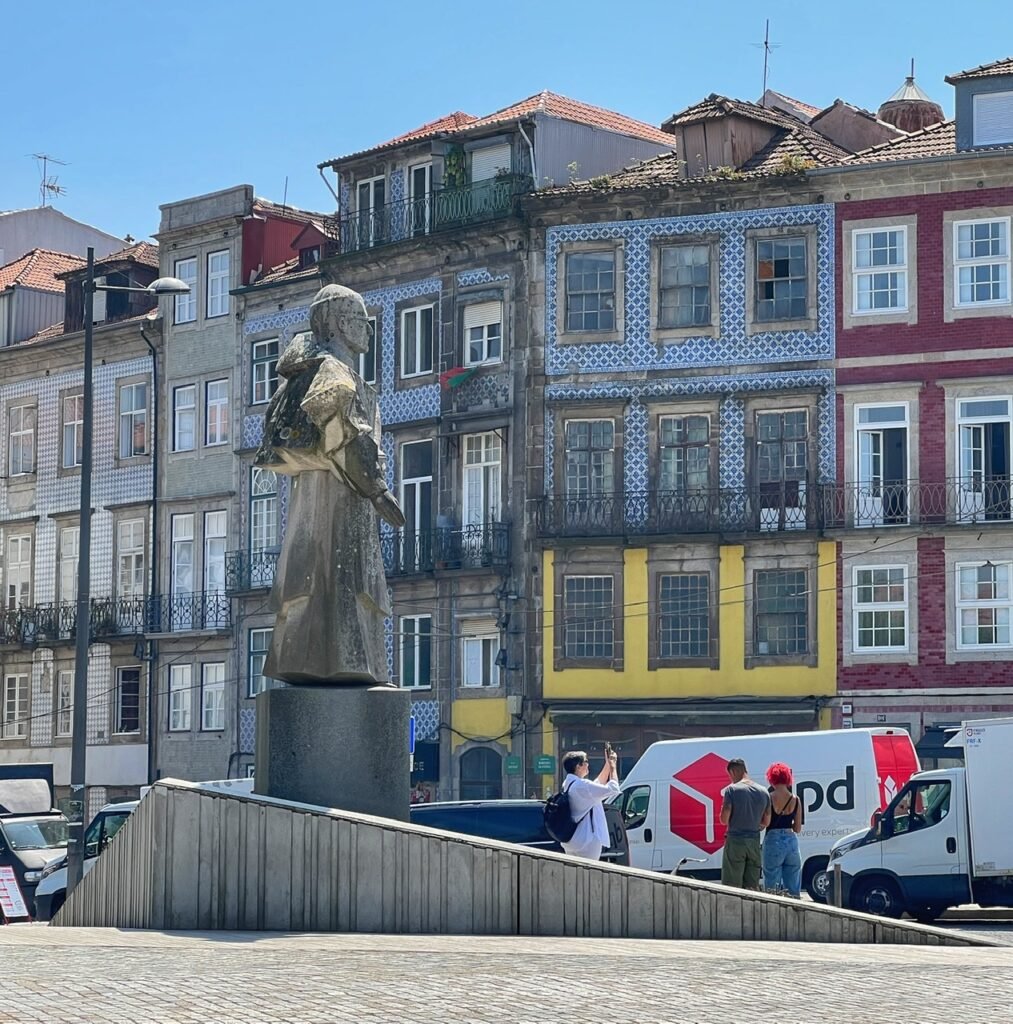
Couldn’t tell who this statue in front of the Clérigos Tower resembles, but it looks like the Pope wearing a hoodie. Maybe he’s trying to appeal to today’s youth?
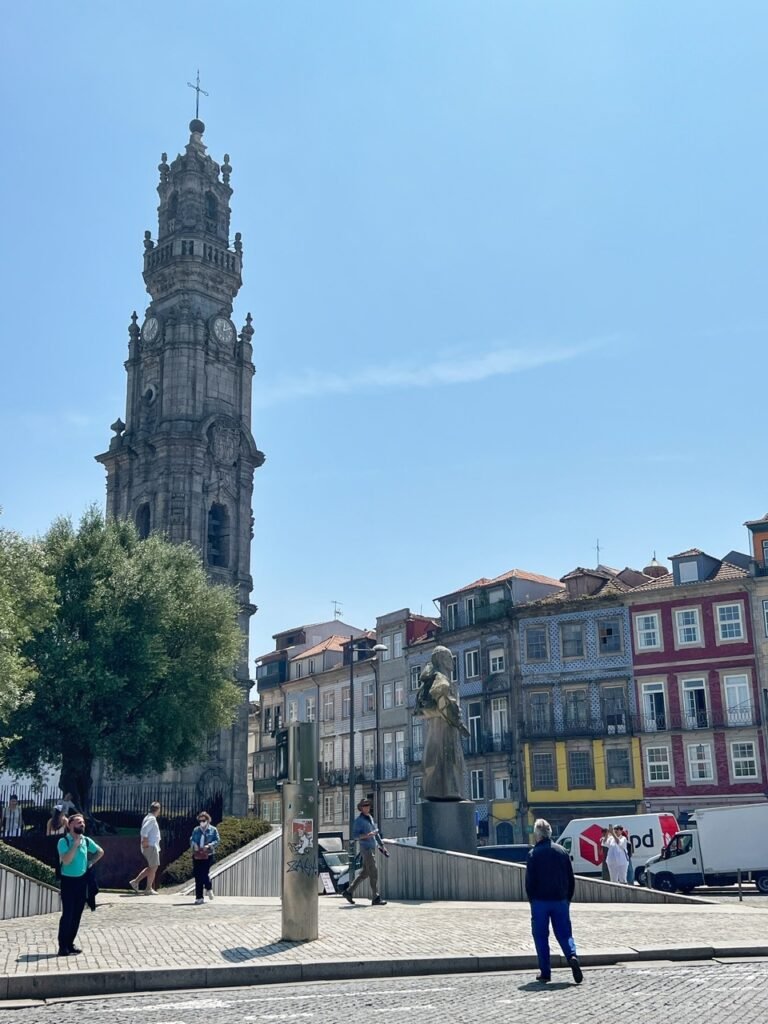
We’re back in tower land! The Clérigos Tower is one of the most noteworthy landmarks in Porto and likes to shove itself into the skyline in almost any photo. It opened in 1763 and was the highest in Portugal at over 75 meters. In 1917, it was climbed by father/son Spanish acrobats in front of an enormous crowd.
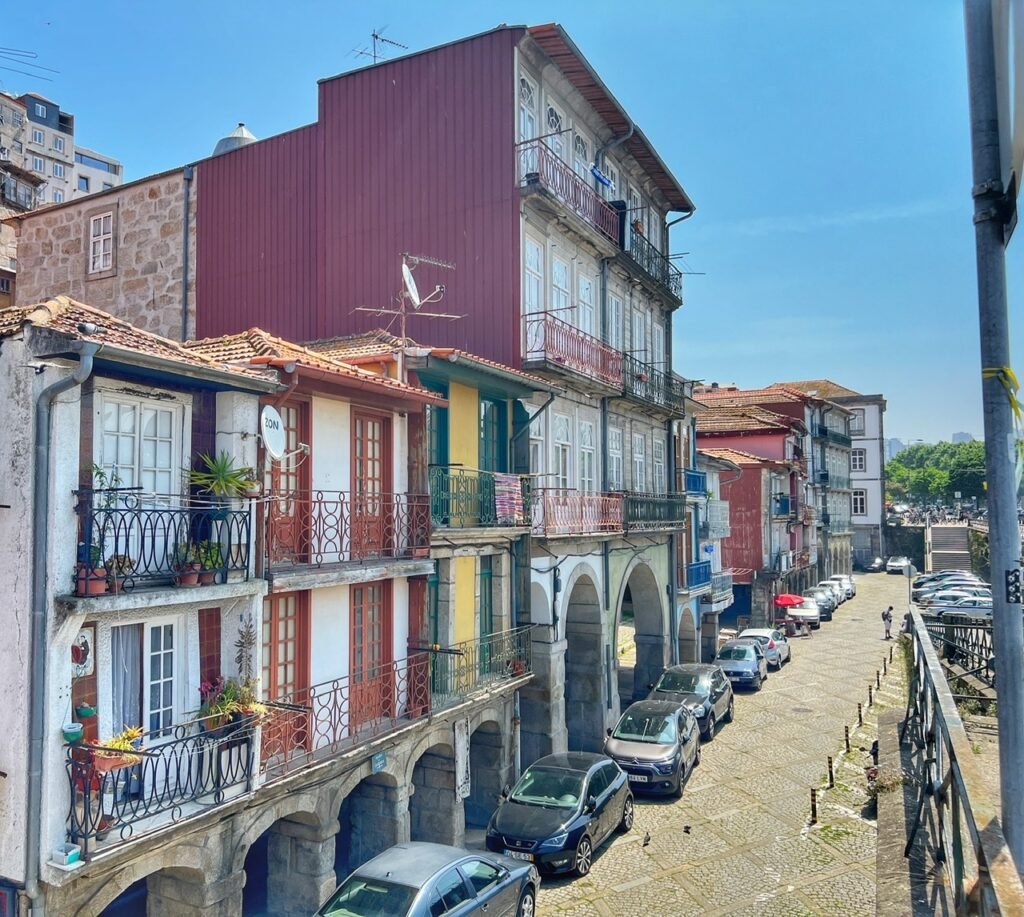
A row of homes, all with balconies….
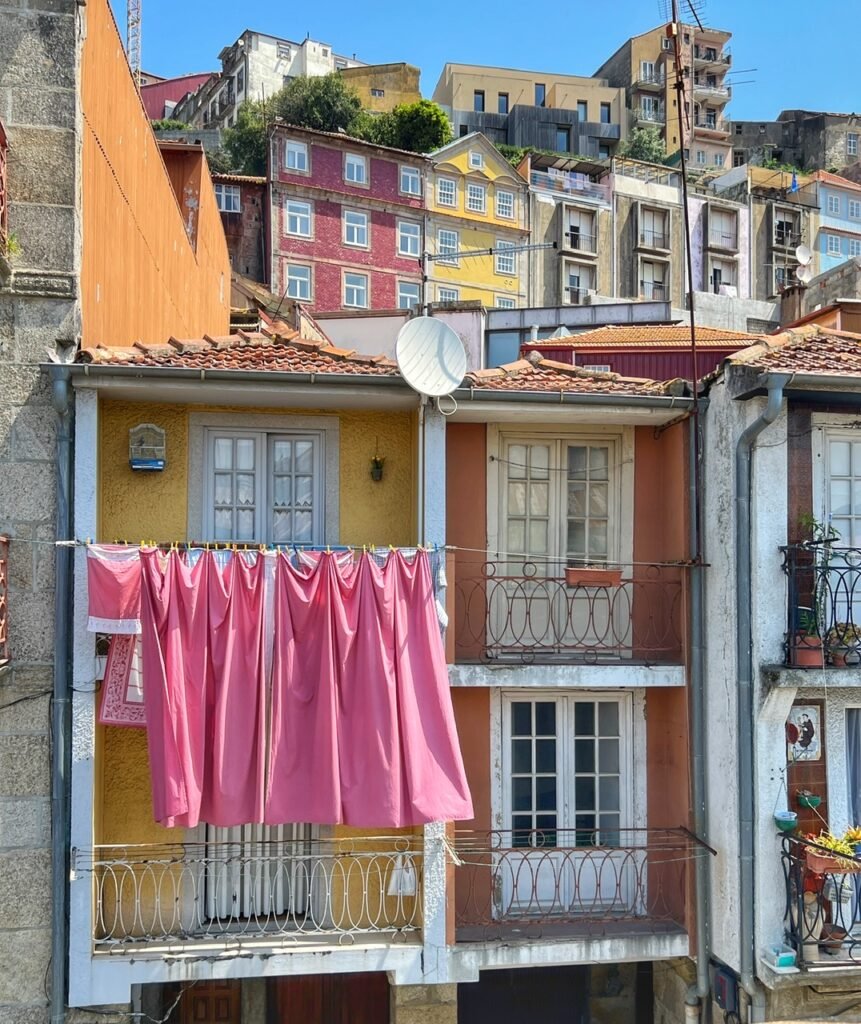
…which are fabulous for your Pepto pink sheets. Please tell us those are for an eight year old.
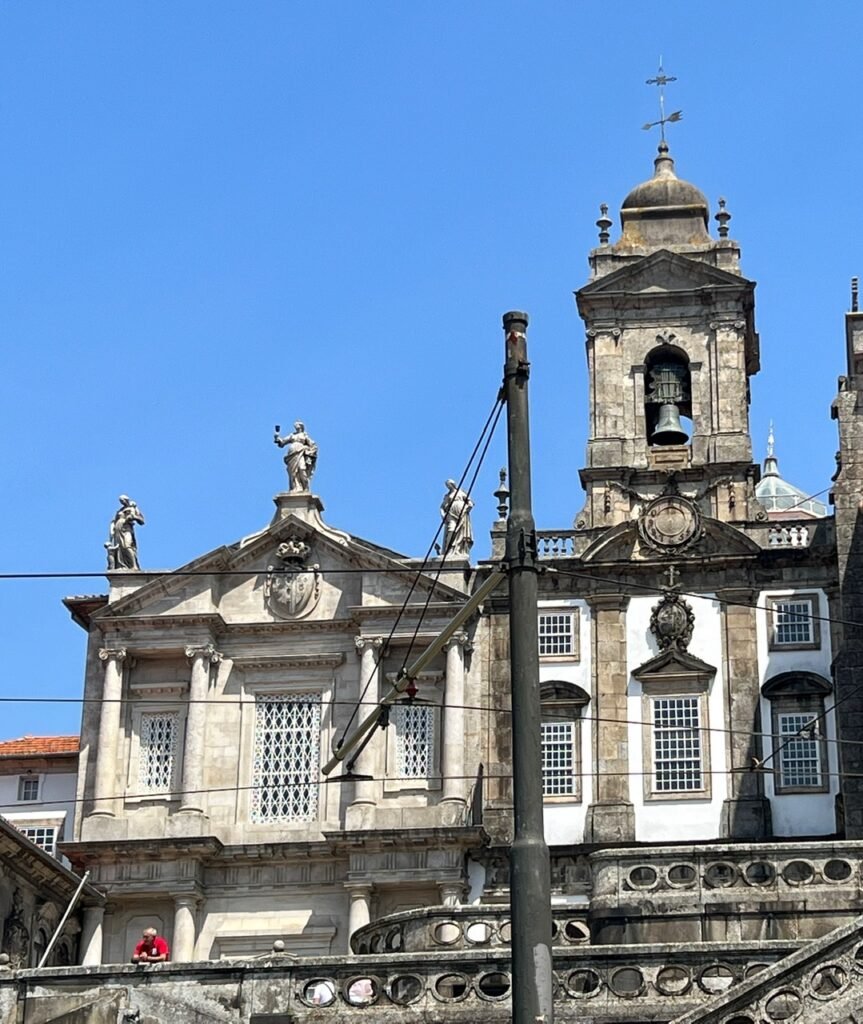
The Bolsa Palace is currently the headquarters of Porto’s commercial association.
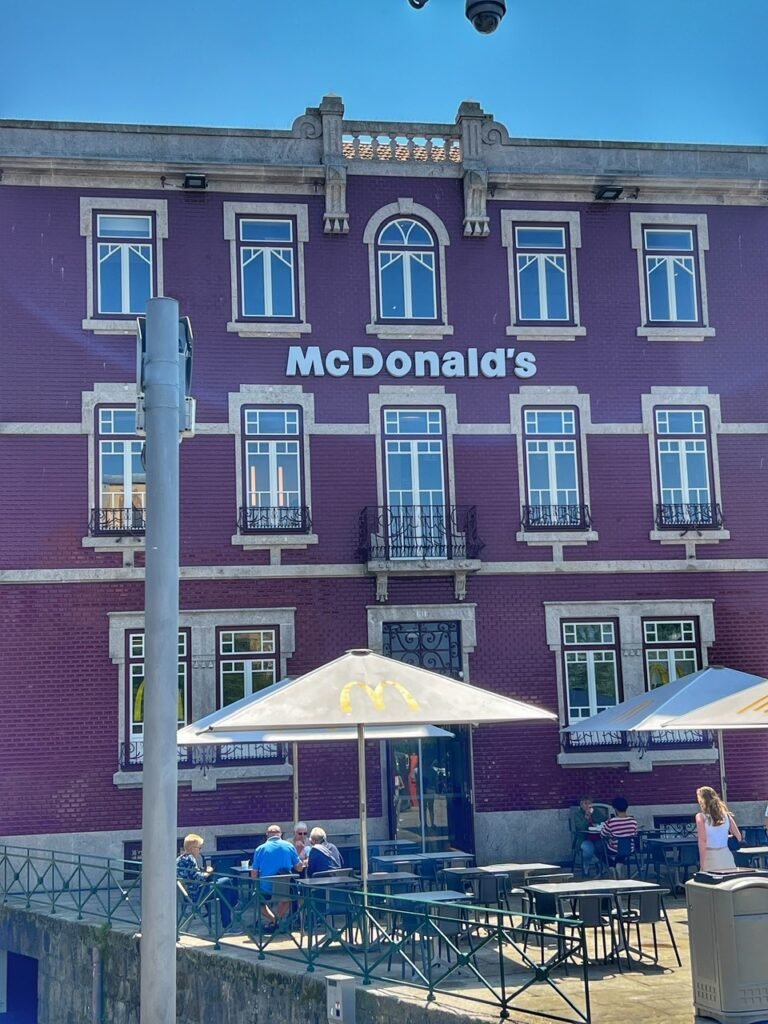
Even the McDonald’s is cute.
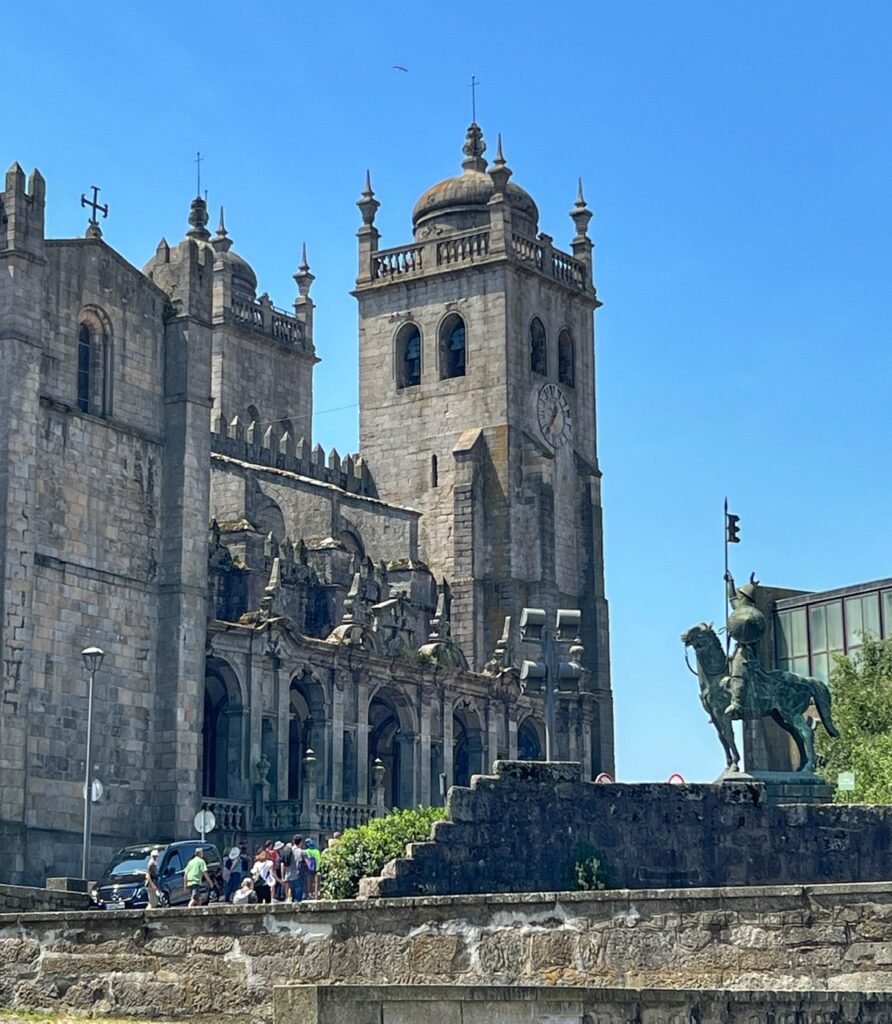
The Porto Cathedral was finished in 1837 but first had its groundbreaking in the 12th Century!! From the outside, it looks a bit like a fortress. This explains why it looks like a mix of architectural styles.
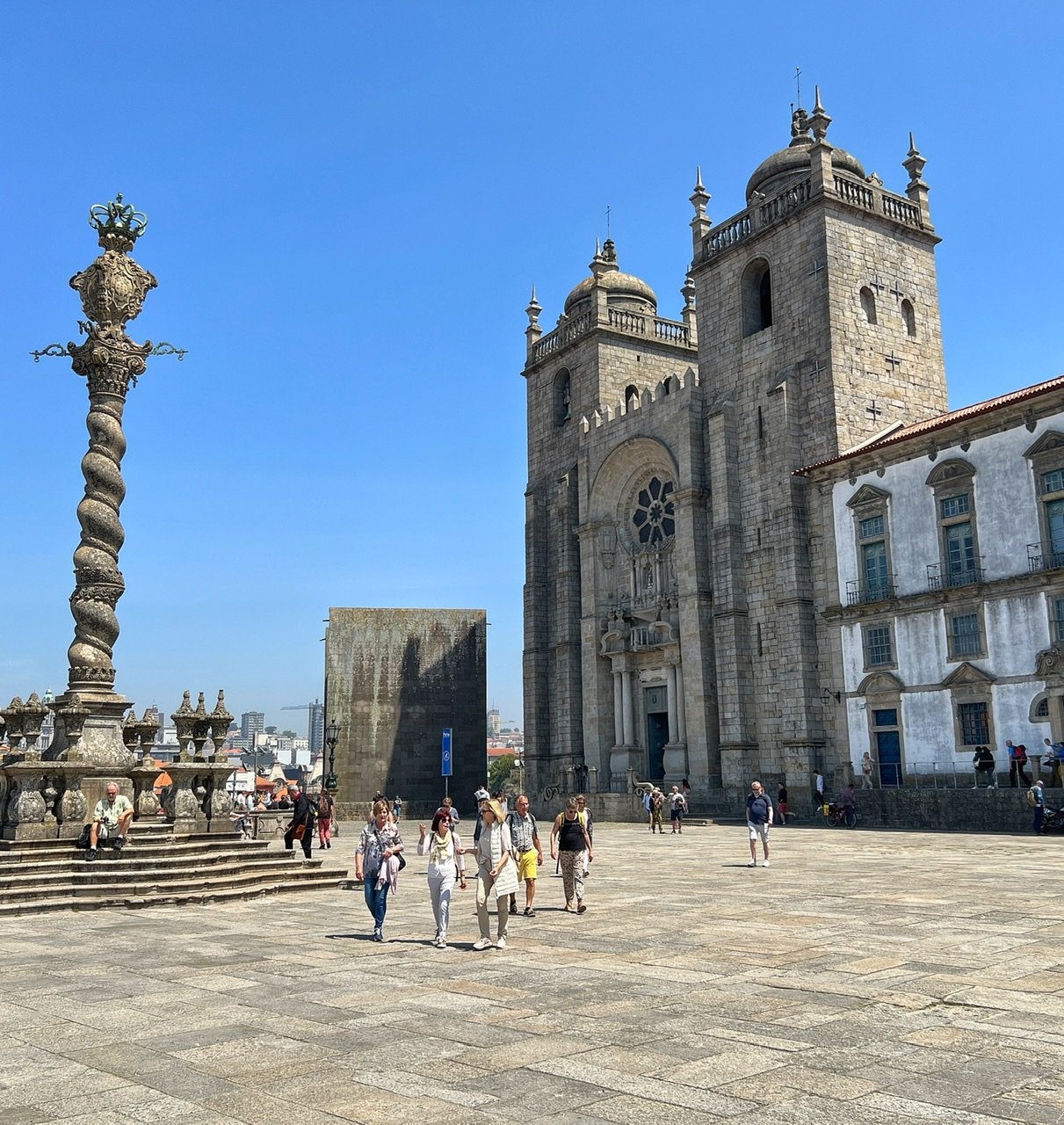
The pretty little pillar out front is where the criminals of Porto were hung.
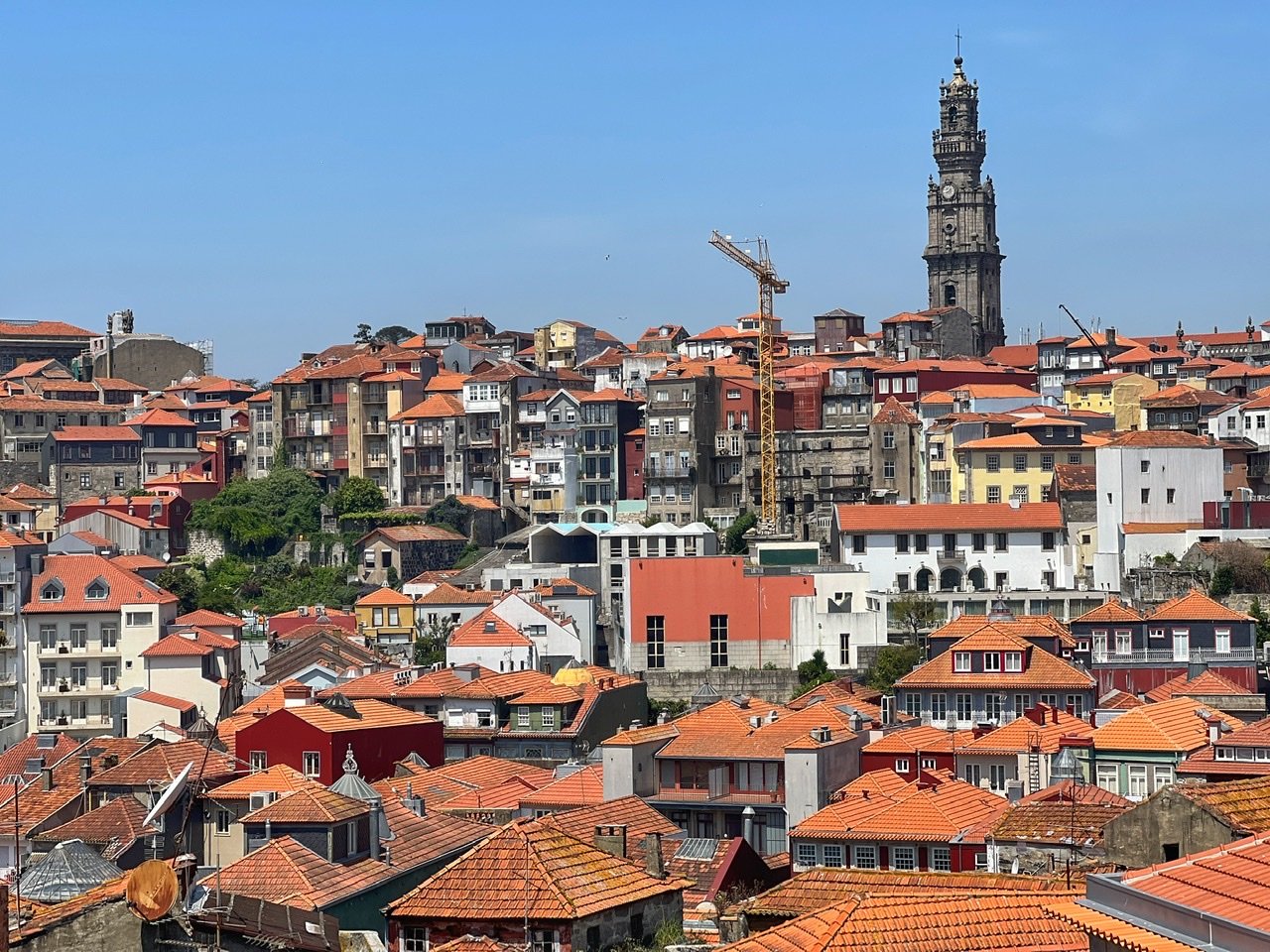
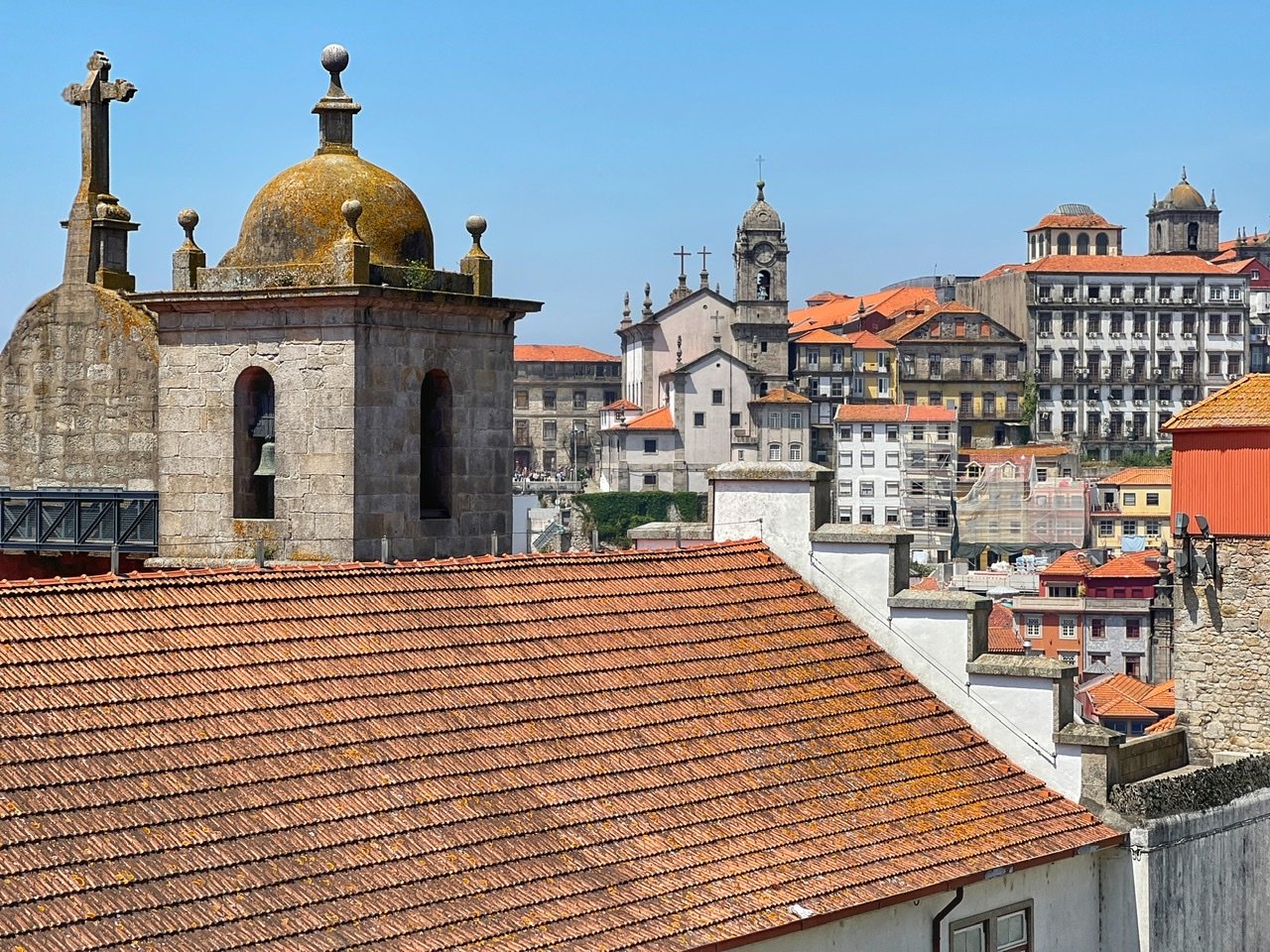
The views up there, which Greg appreciated solo, were absolutely phenomenal. This view on the right felt a bit like Edinburgh dosed with red roof tops.
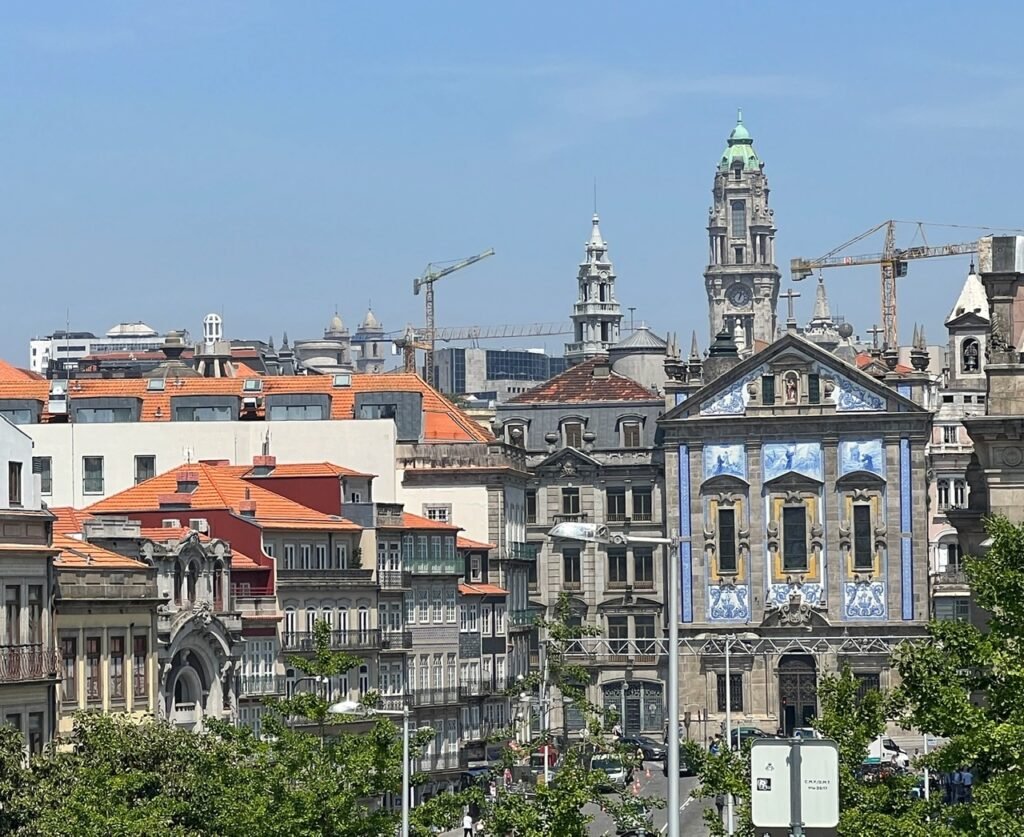
And there’s that tower, like a Great Dane sticking its head up who always wants attention. (We wrote this when housesitting a Great Dane so it felt applicable!)
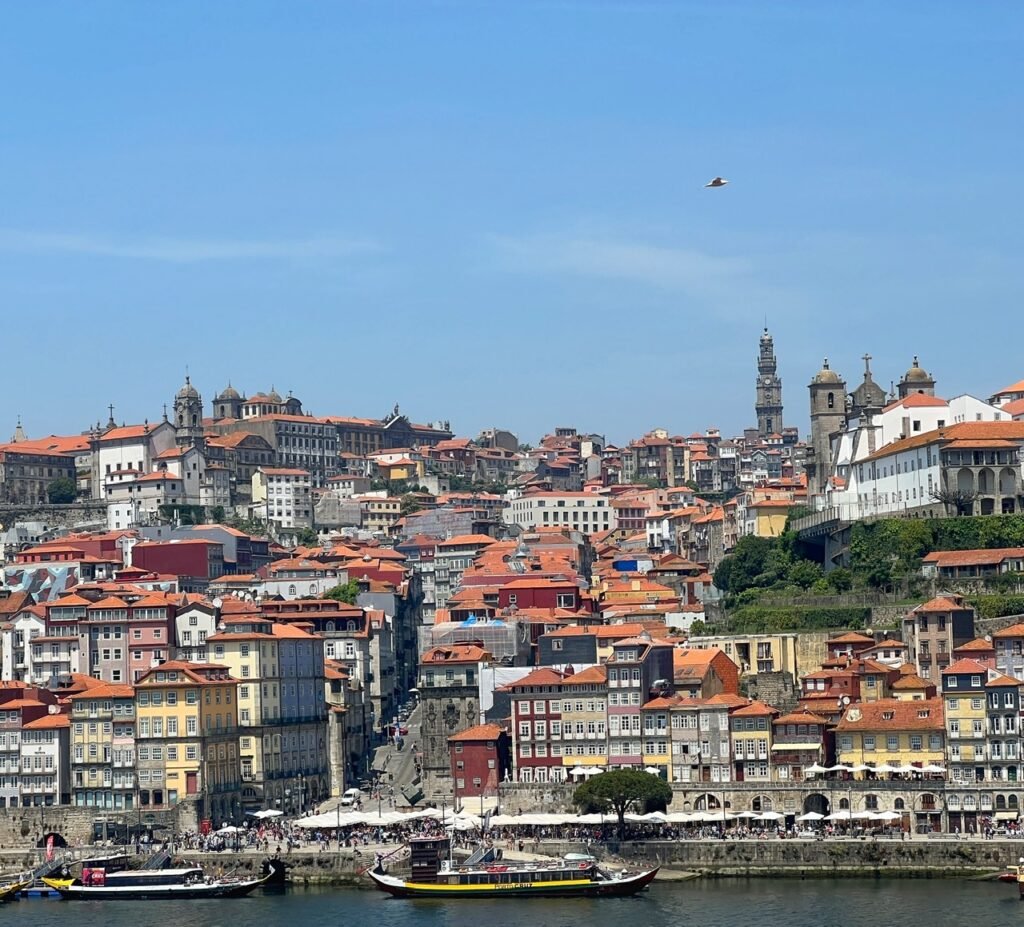
Unfortunately we were unable to cross the famous Ponte Luis I bridge into the adjoining city of Vila Nova de Gaia, so we chugged with all the other gas guzzlers around to the car bridge.
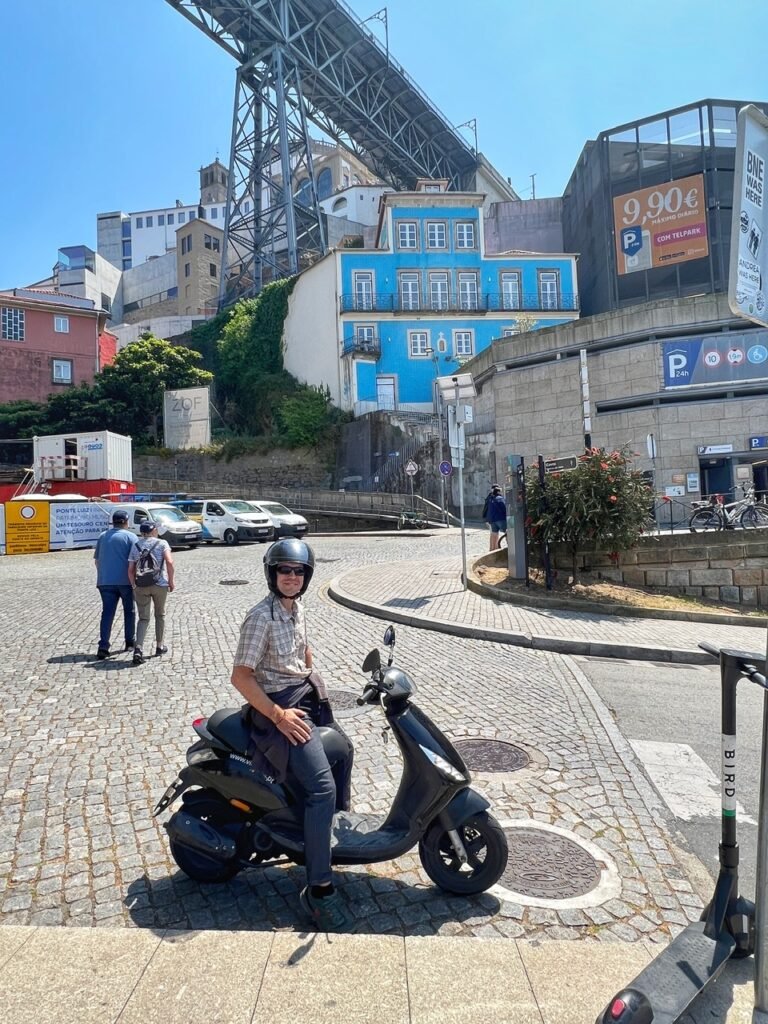
Greg, happy to take a break from the crazy Google lady, pauses under the bridge….
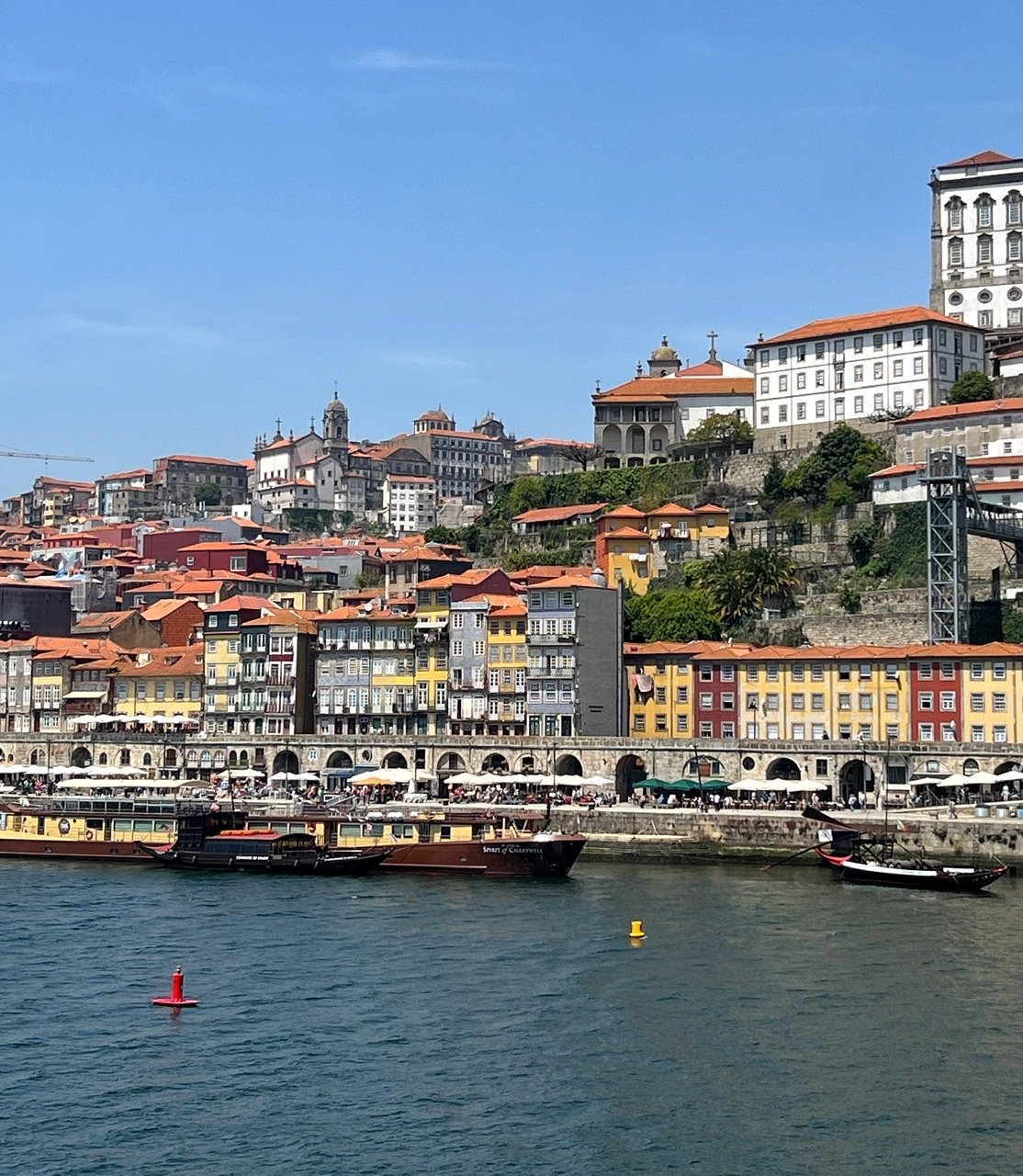
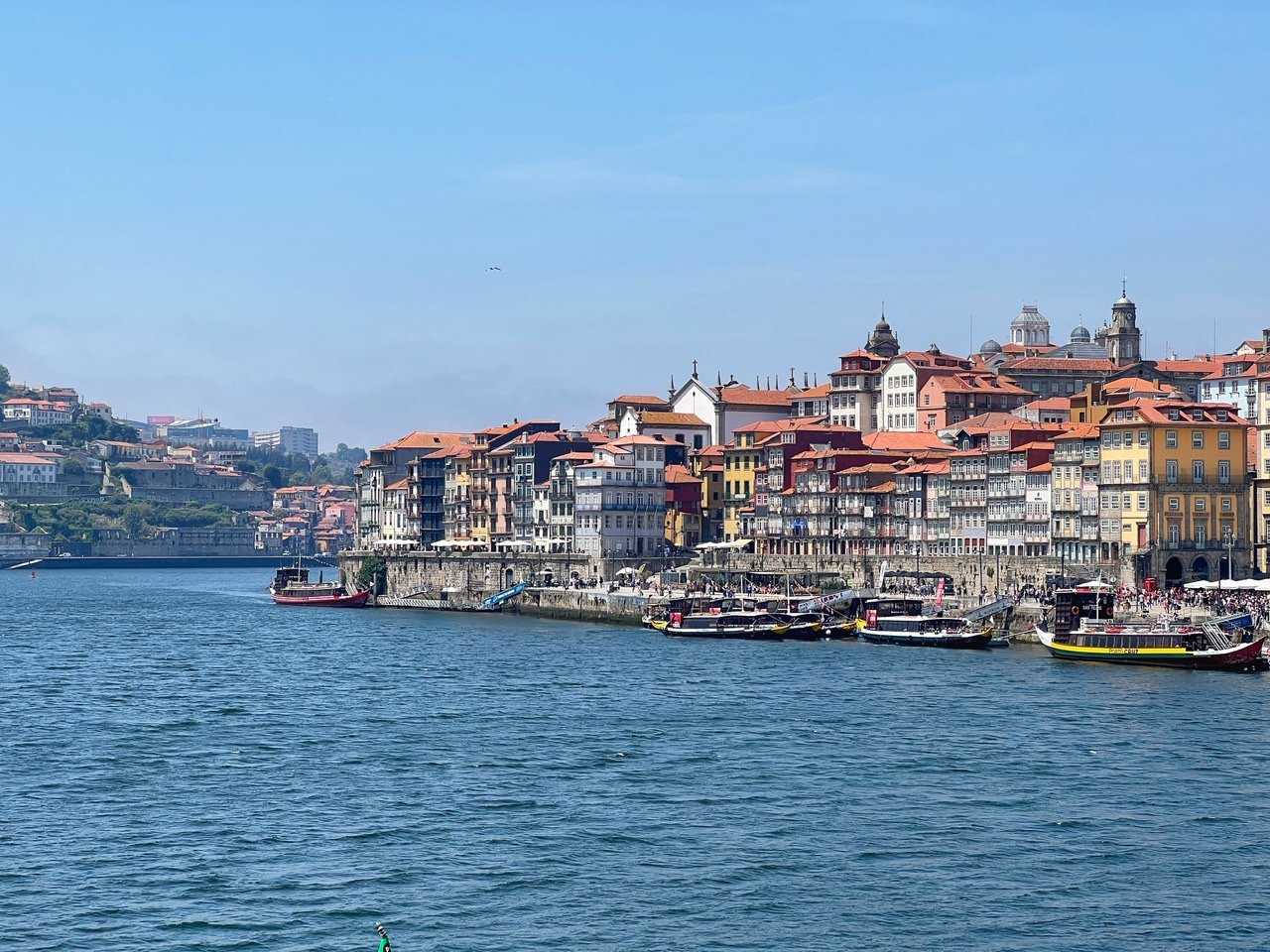
…while Mandy shuffles to the eye candy before us.
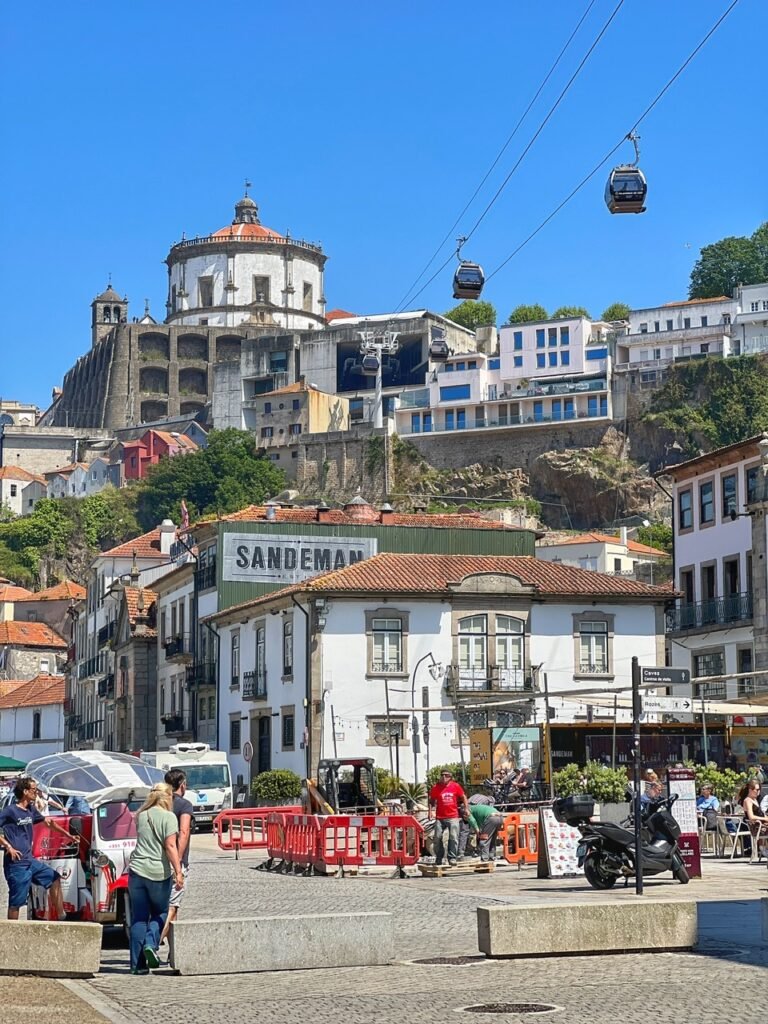
We scooted along the edge of the water where tons of tourists were congregating and getting tipsy on port wine. It is here you also have the option to take a 6€ teleférico ride to the top of this park. Or, you can walk it (for those that can!), in about 15 minutes.
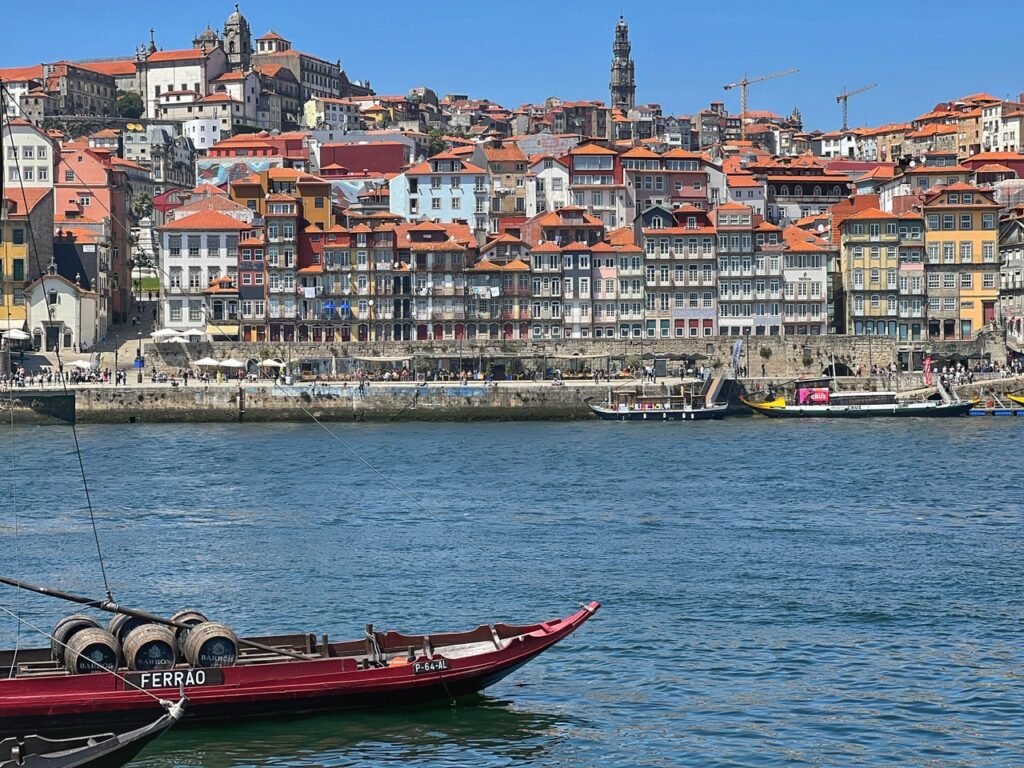
The views from this side are undeniably the best!
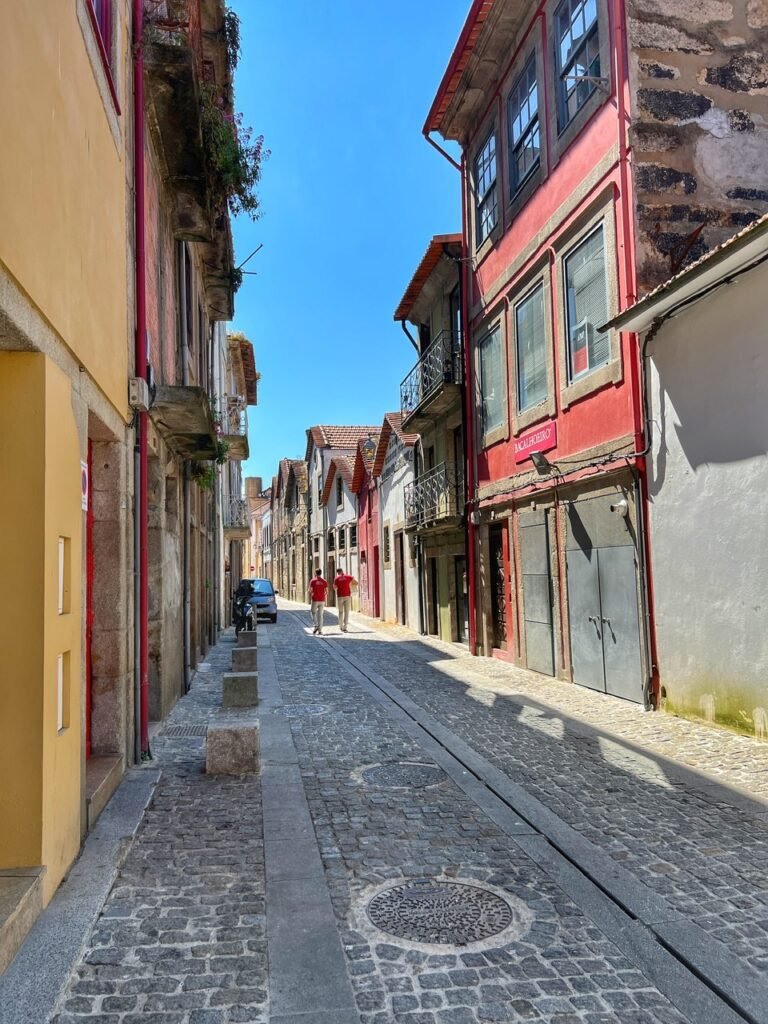
You go one street back and the streets of Vila Nova de Gaia were charming and utterly empty.
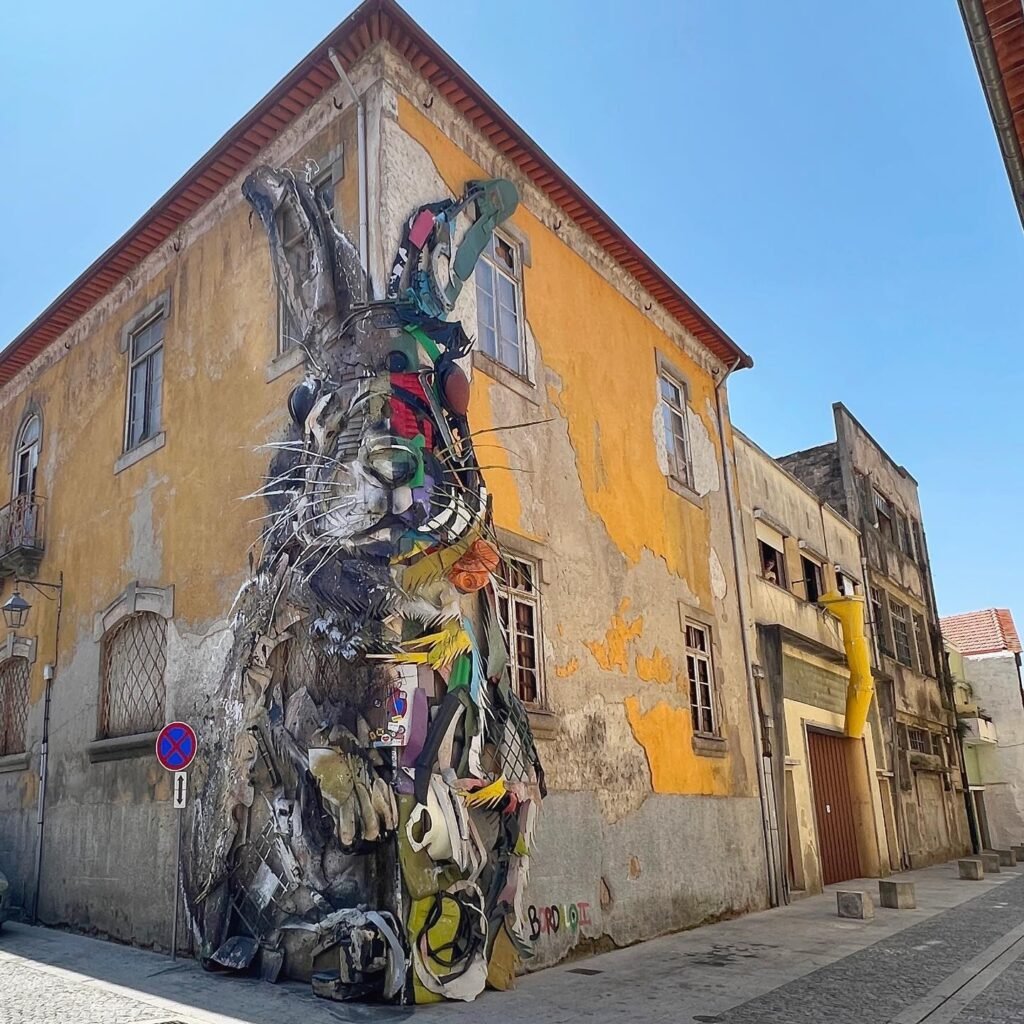
Also in Vila Nova de Gaia, O Coelho or “The Rabbit” created by Bórdalo II is some of the most exceptionally ingenious 3D street art we’ve ever seen. Every item in its creation is made of materials that would otherwise be disposed. Just stellar!
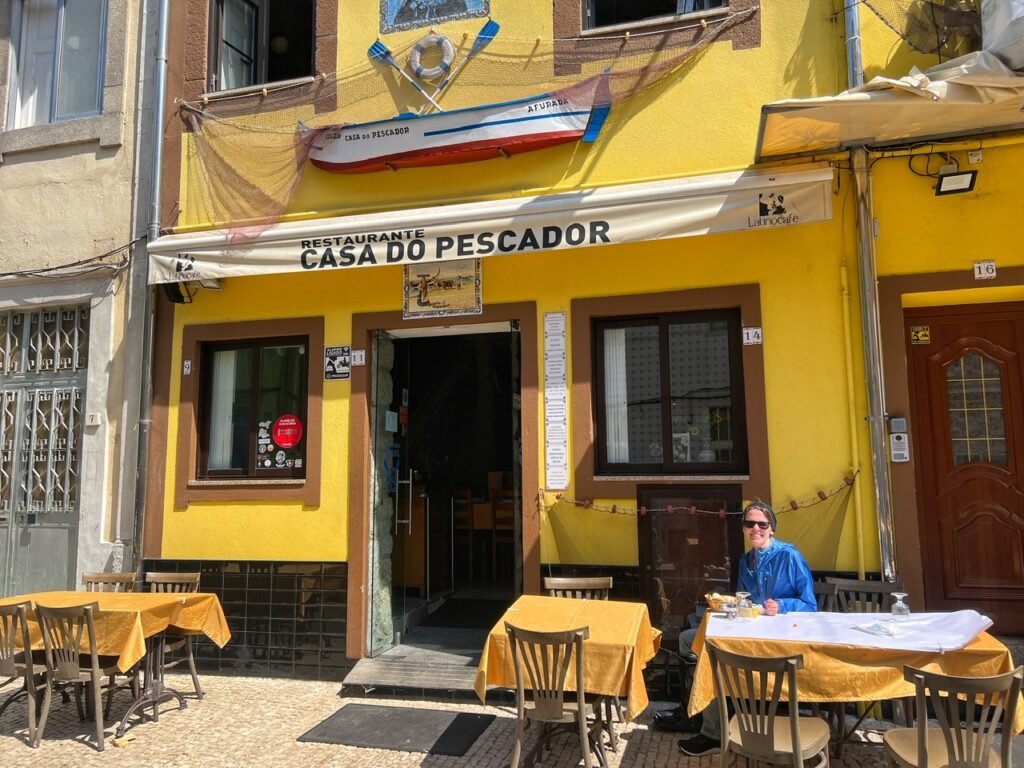
En route to the beach, we grabbed lunch at Casa do Pescador.
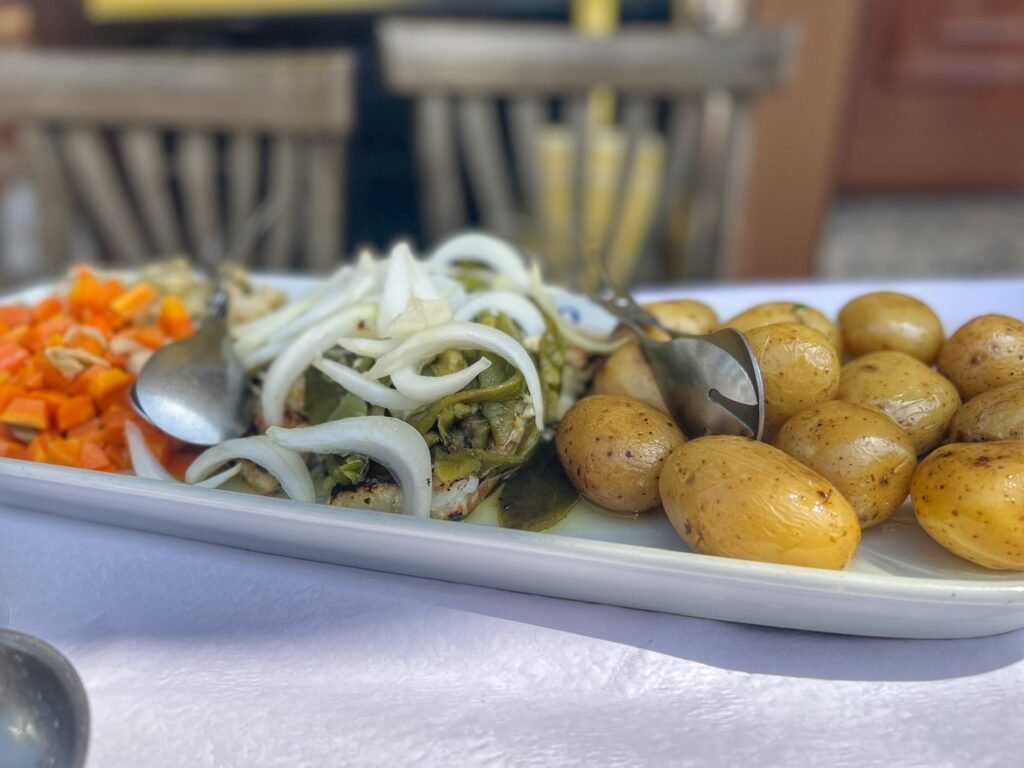
Which included a pile of delicious baked cod and lots of veggies for 10€ each.
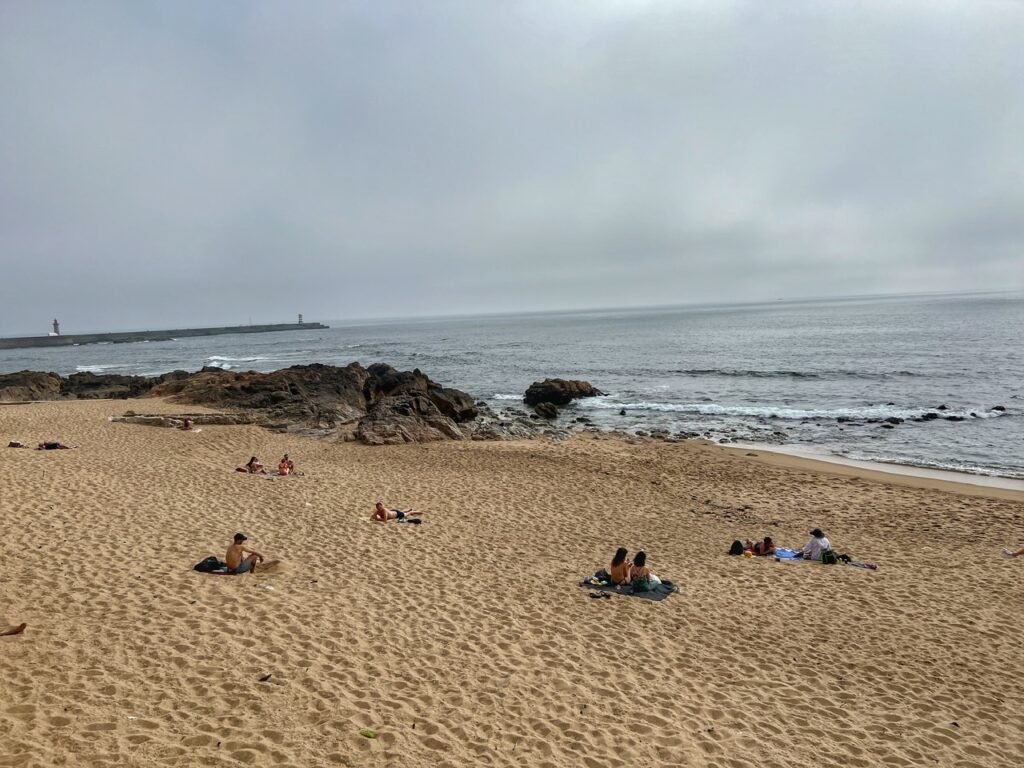
Arriving to the beach…where the grey sky had sadly swept away much of the sun. Probably to keep the topless ladies and their Brazilian g-strings from getting burned. Ahhh…yes we’re back in Europe ?
Just an aside…Speaking of Brazilians, we have met more Brazilians living in Portugal than Portuguese people. It seems they are flocking here in droves thanks to the language, easy residency status, and better way of life.
The problem with this is when you’re trying to learn Portuguese and the main greetings are different. This is much like the differences in Latin American and Castillian Spanish. For example, “Boa tarde” is pronounced with a soft -jay sound at the end in Brazil and -day sound in Portugal. While our Spanish helps in reading Portuguese, it’s quite unhelpful in understanding it spoken as the pronunciation is drastically different. This is evidently because it developed before Spanish and stems from what was called “Vulgar Latin” which was the informal or colloquial form of Latin. Who knew?! We have heard that native Portuguese speakers can understand Spanish (Castillian) speakers much easier than the other way around.
Cafe Culture at a Confeitaria
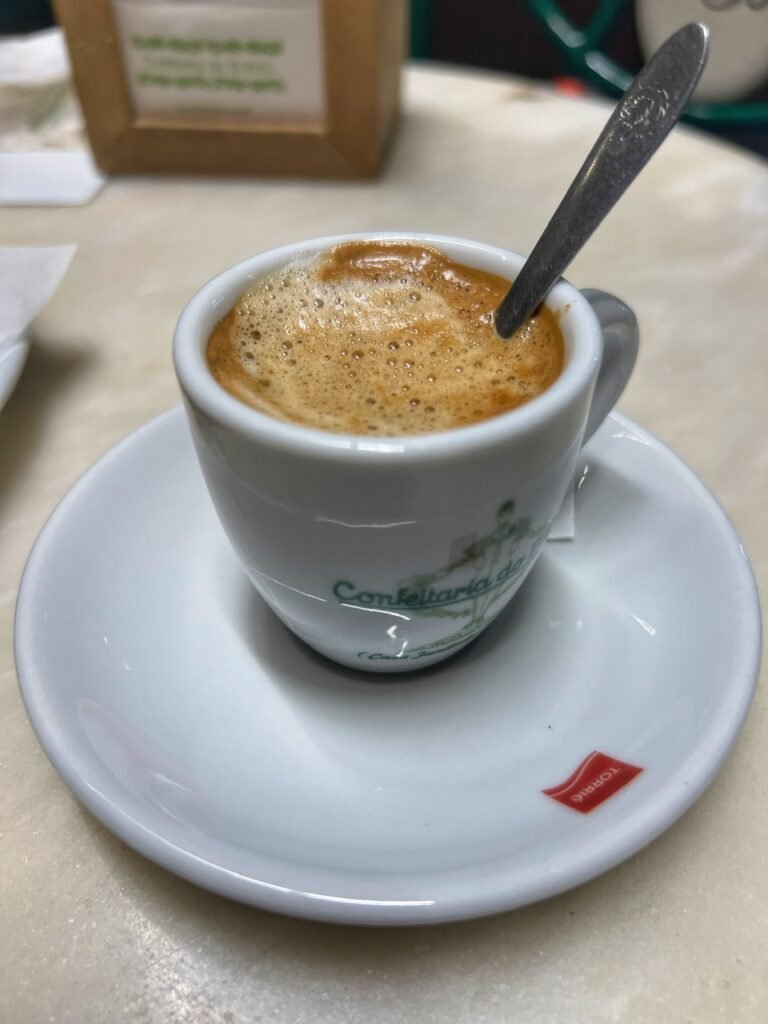
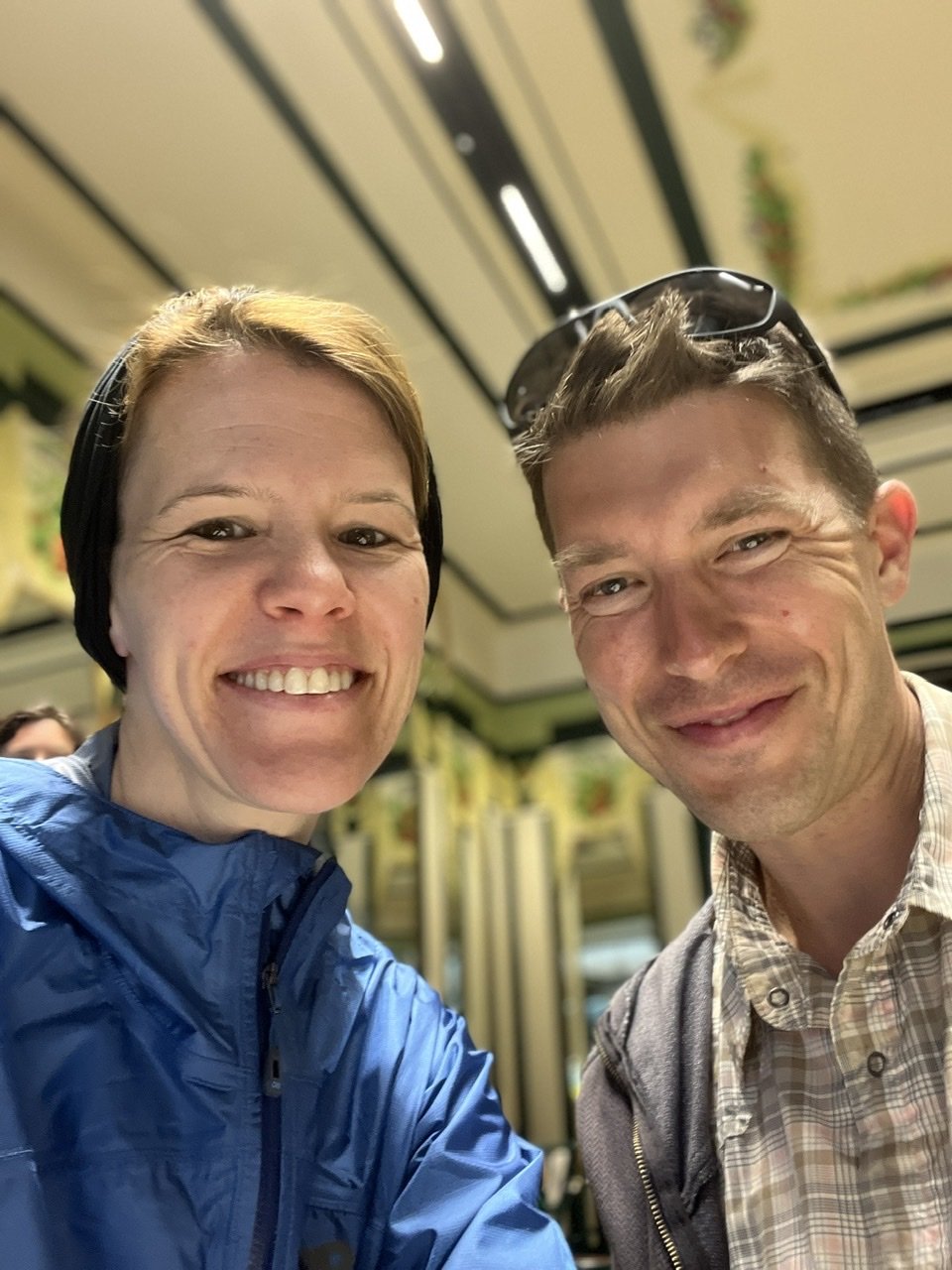
Did you know the average Portuguese adult consumes over 4 kilograms of coffee beans per year? On another day, we had to go embrace coffee culture in a charming and historic venue at Confeitaria do Bolhão. Cost for two coffees and four mini pastries was 4€
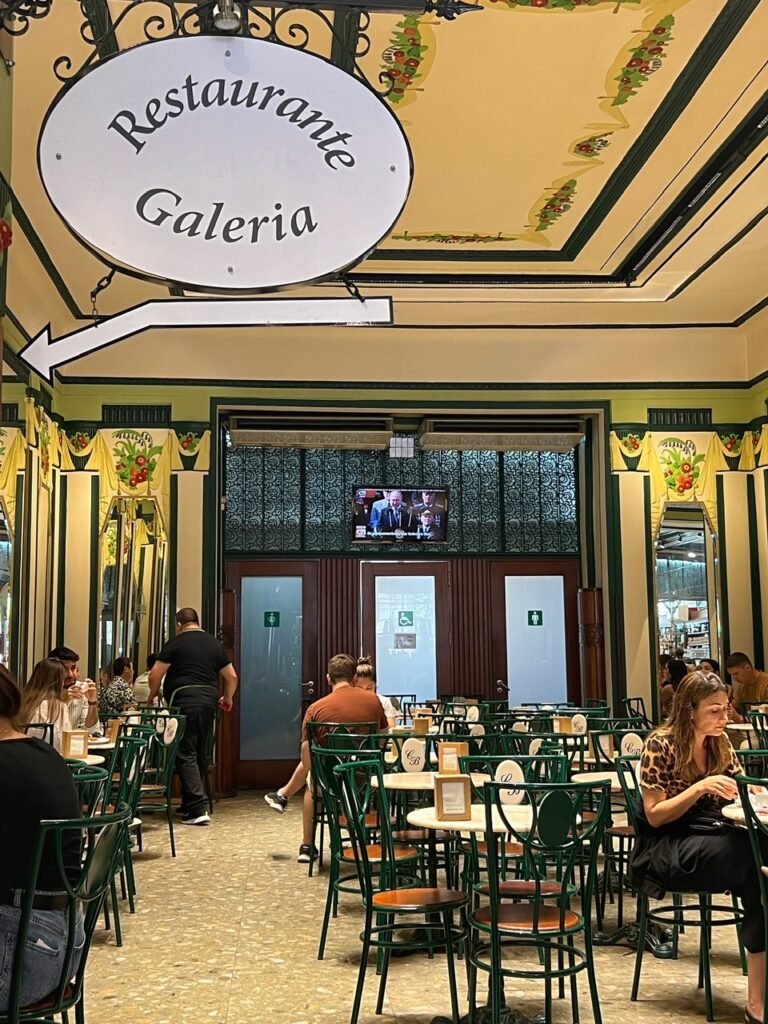
Sit down or carry out options available.
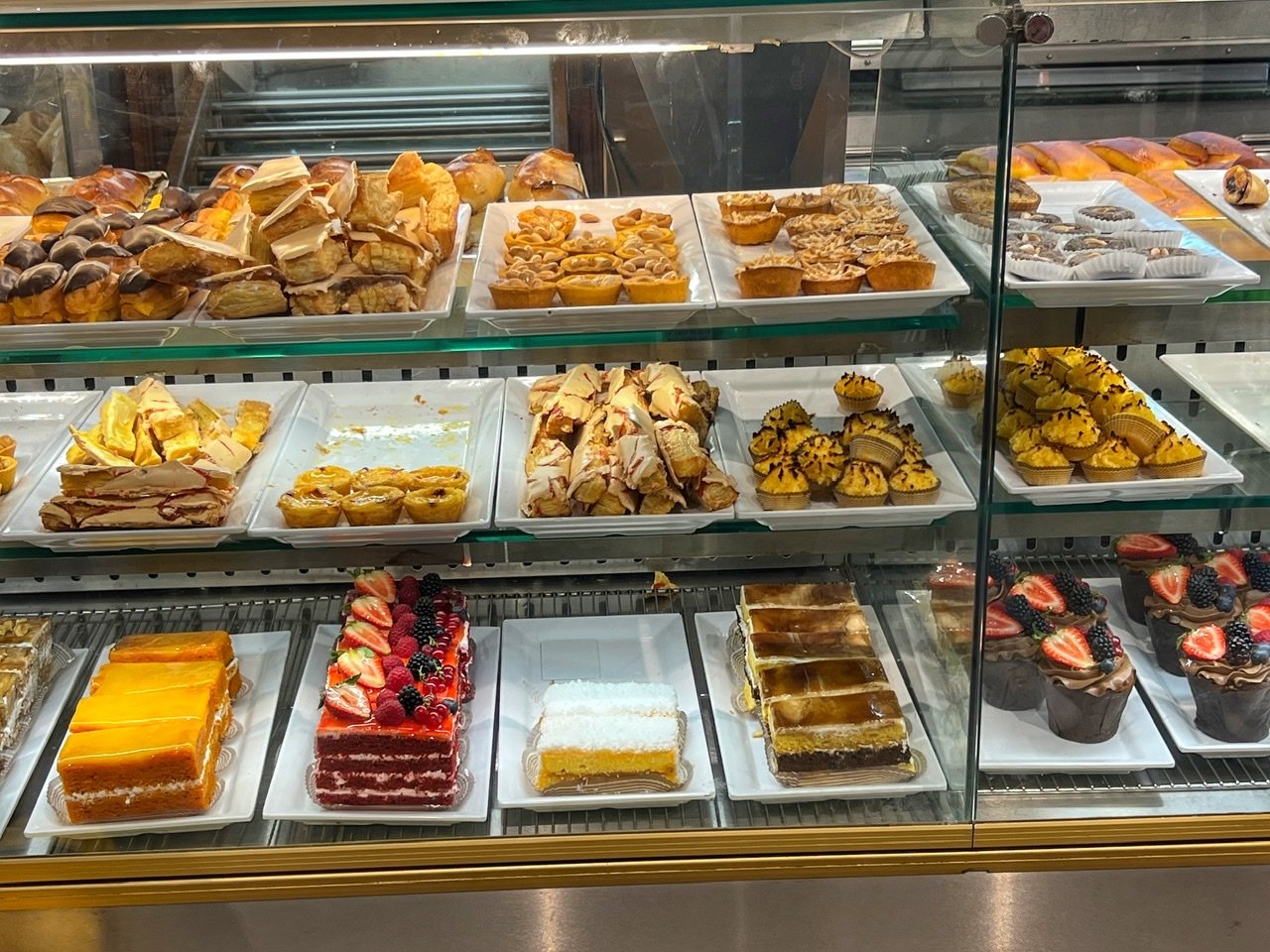
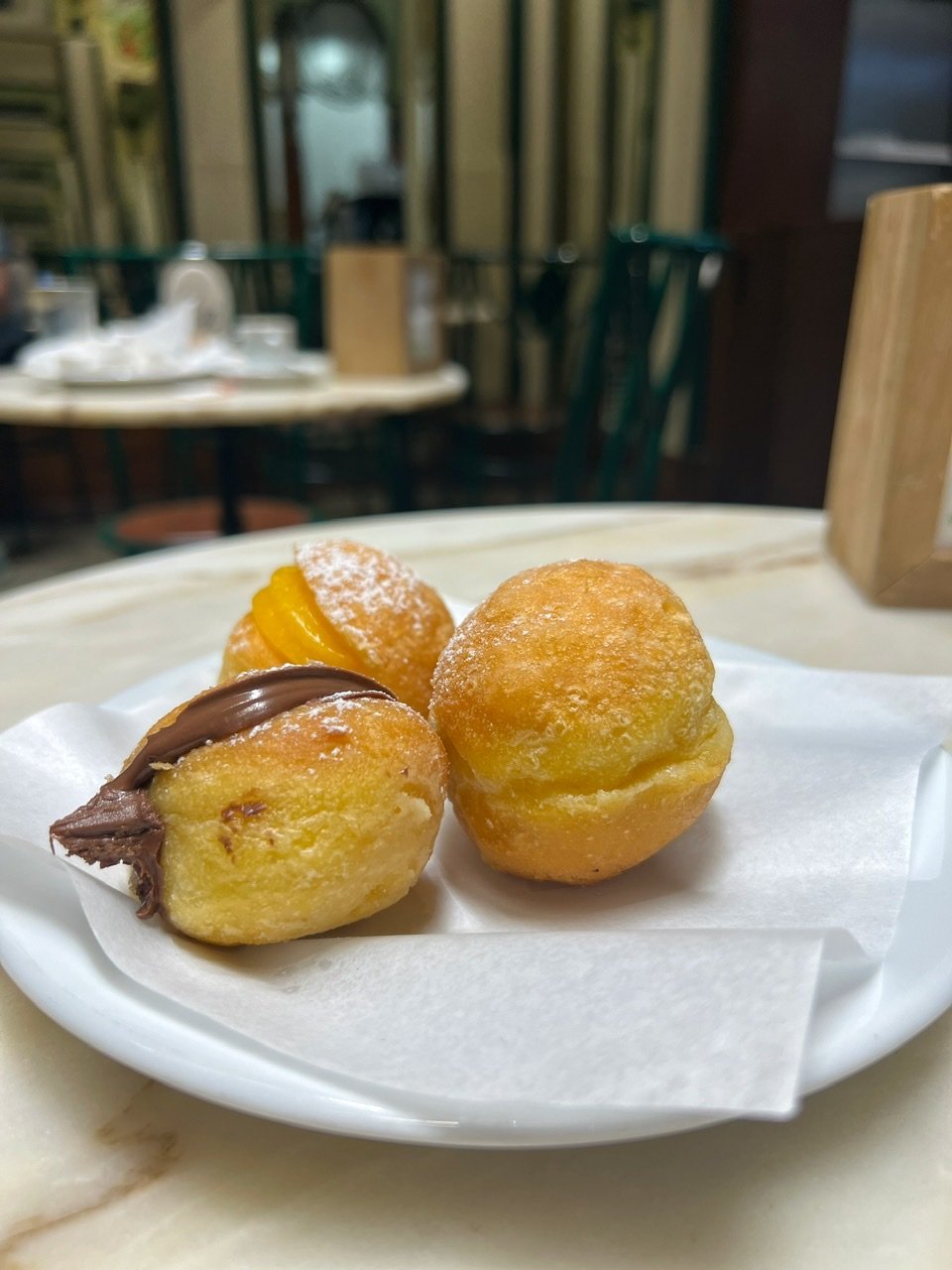
And mmm…pastries galore!! One of each needs to be stuffed in our food holes. We settled for four adorable little pastries at .50€ each. Oops. Greg already ate one before Mandy grabbed a photo of the fourth.
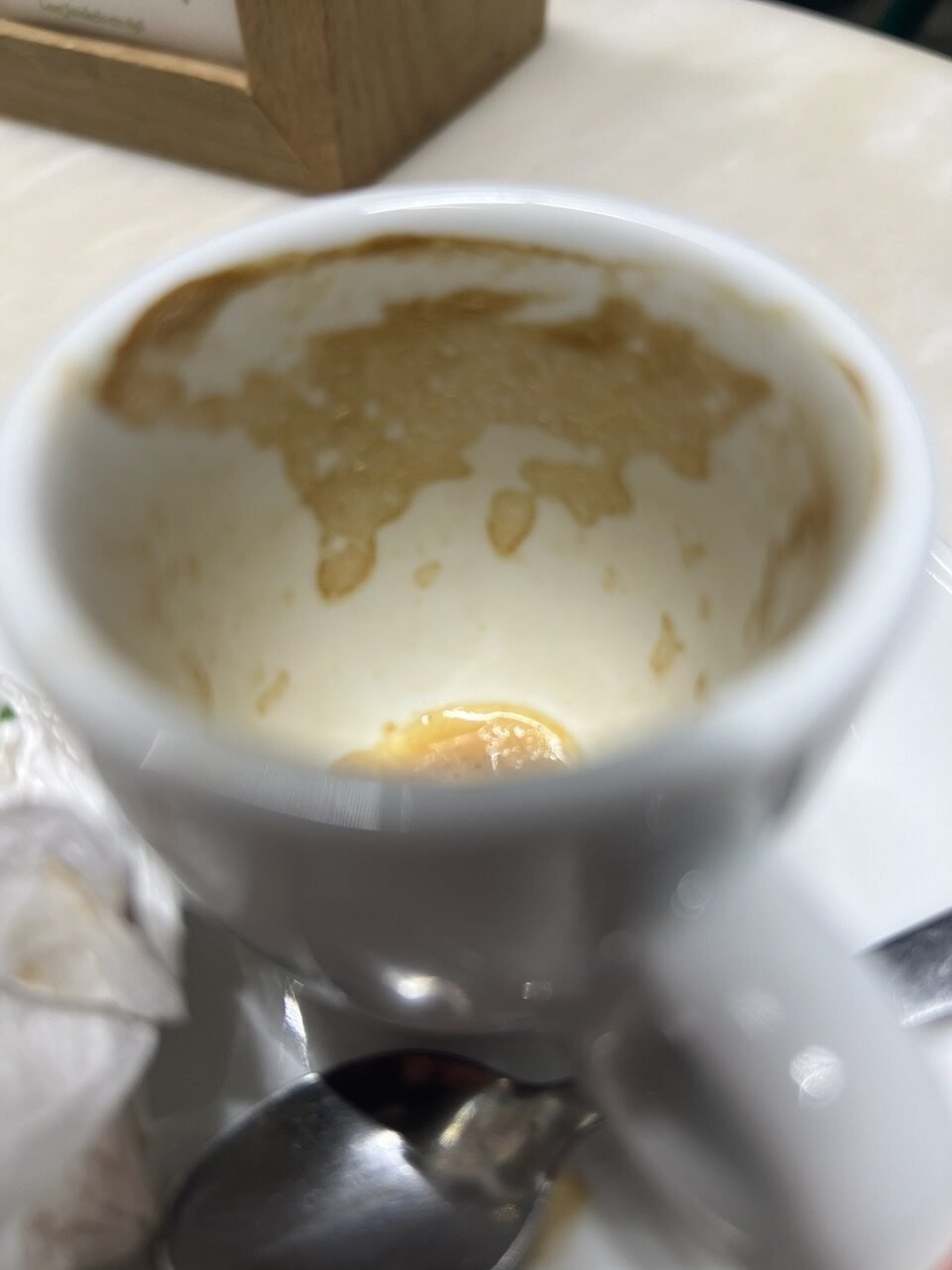
A Euro-friendly thimble full of Macchiato slurped up. Despite Mandy’s challenges as of late, if there was ever a sign in her coffee cup that she’s in the right place at the right time. Do you see it too?
Ribeira Neighborhood
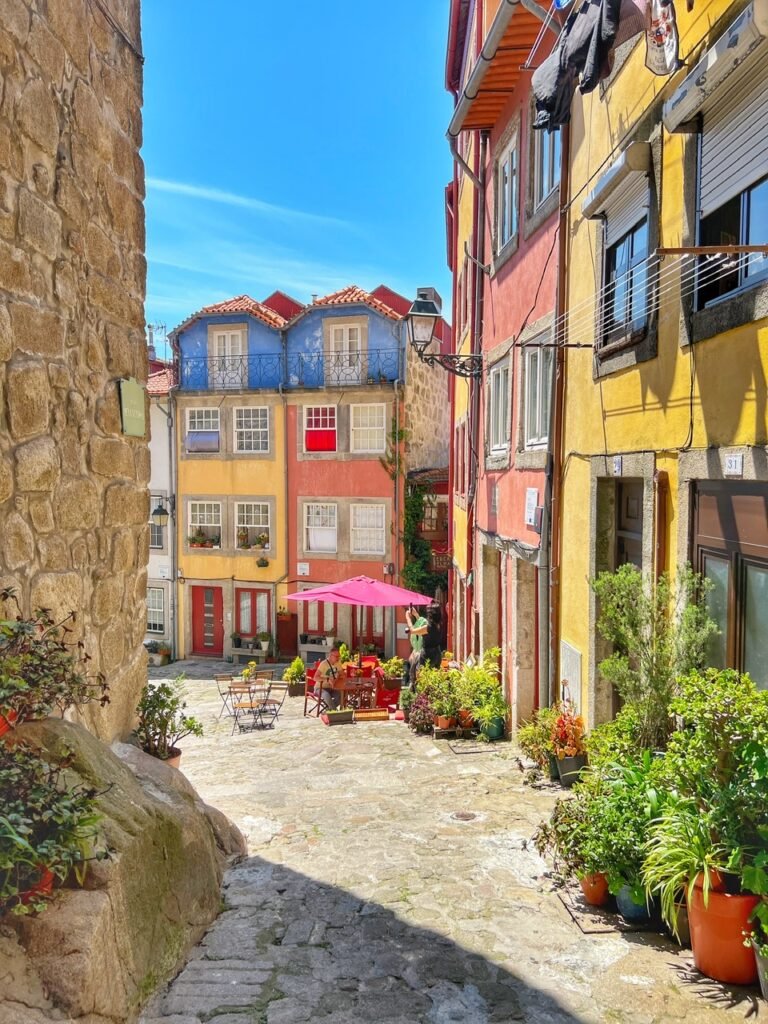
Want to feel like you’re wandering through the pages of a storybook? Look no further than the twisting and narrow cobble-stoned alleys of the Ribeira UNESCO World Heritage neighborhood in Porto. This district, which translates to “riverside” is the oldest in Porto and has been the commercial center since Roman times. Unfortunately, we didn’t get to do it justice, but there’s always the possibility of returning!!
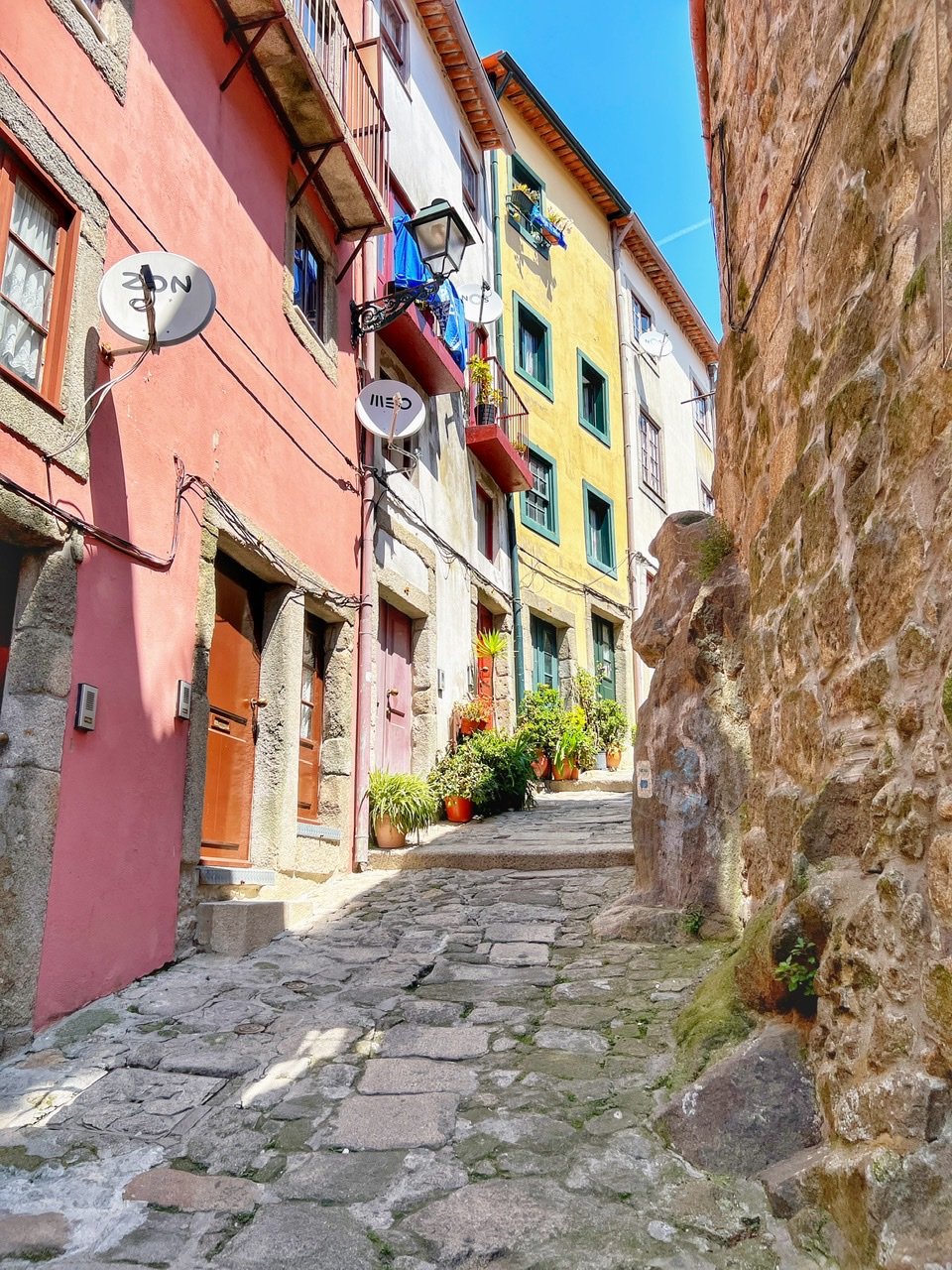
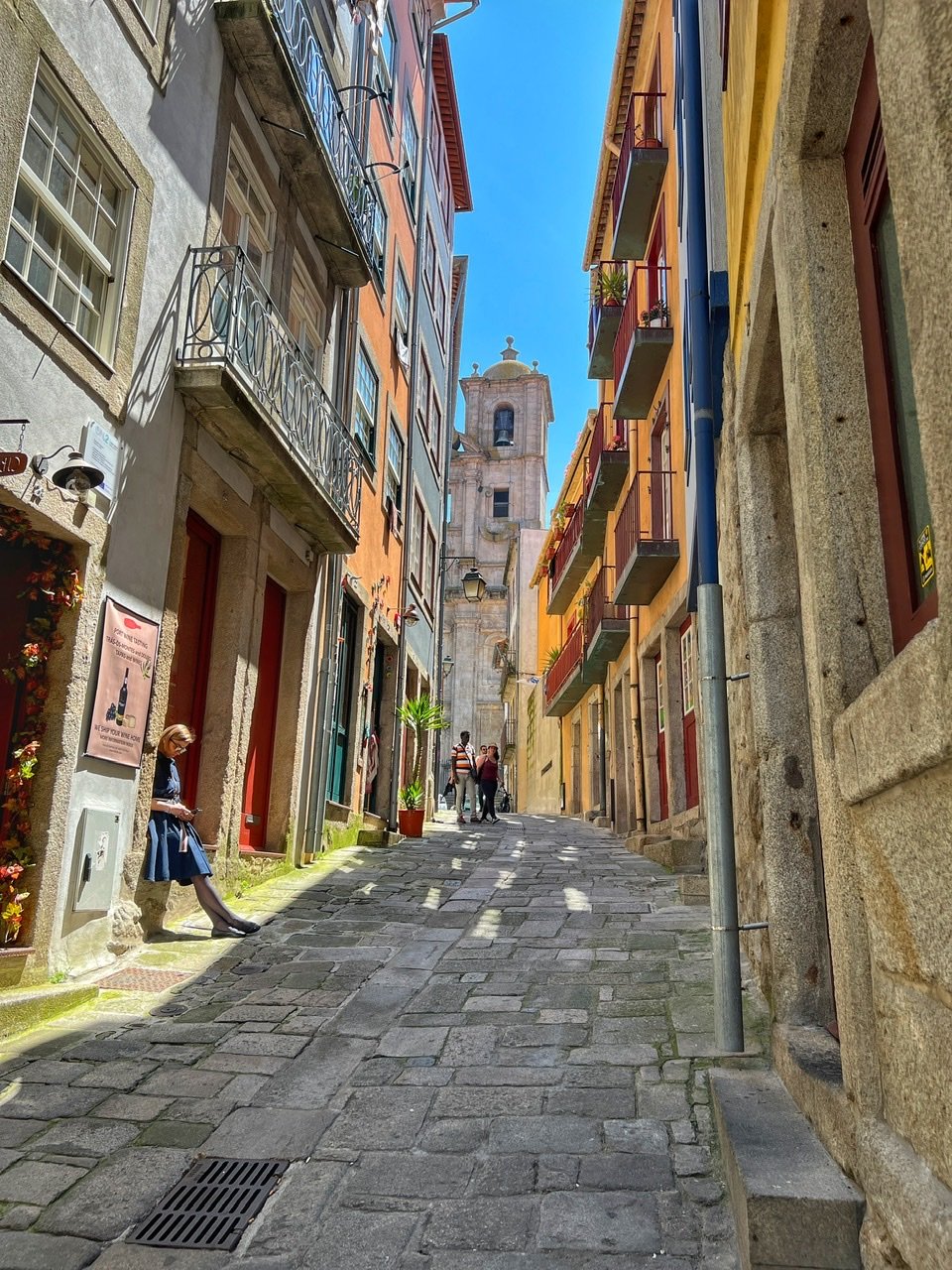
Greg had to be quite strategic in getting these crowd less shots. It’s incredibly busy in Ribeira and Porto in general this time of year. Certainly made us yearn for the charm of Eastern Europe for this reason. Because this neighborhood is exclusively pedestrian, Mandy missed out for sure!
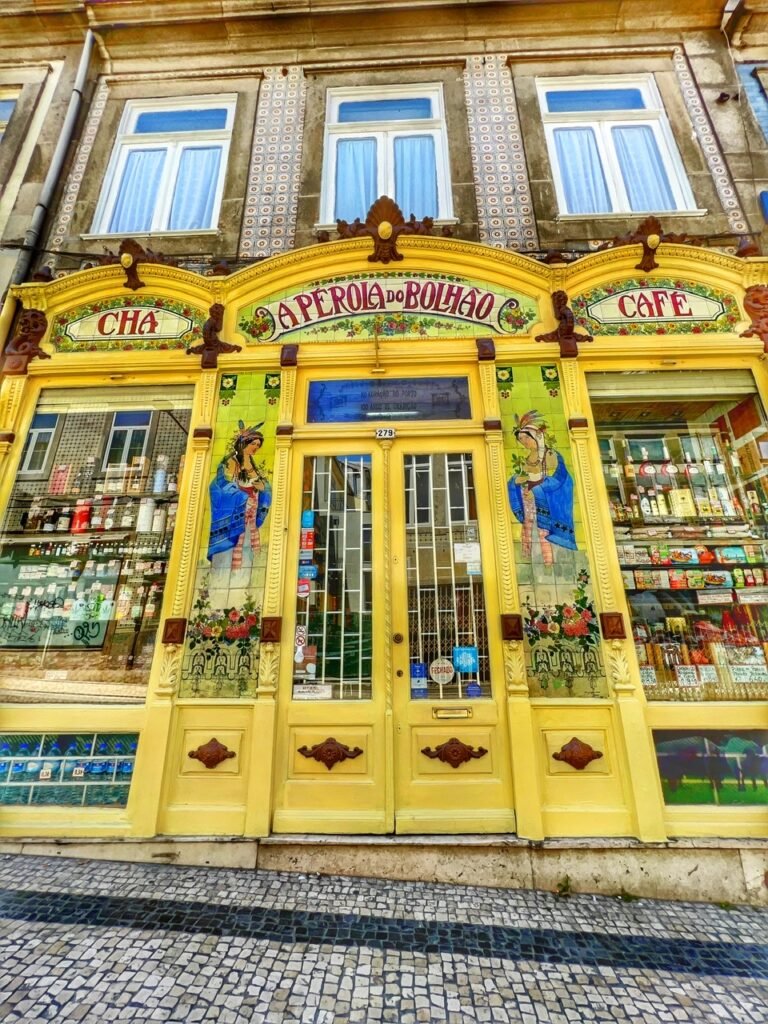
A stunning storefront.
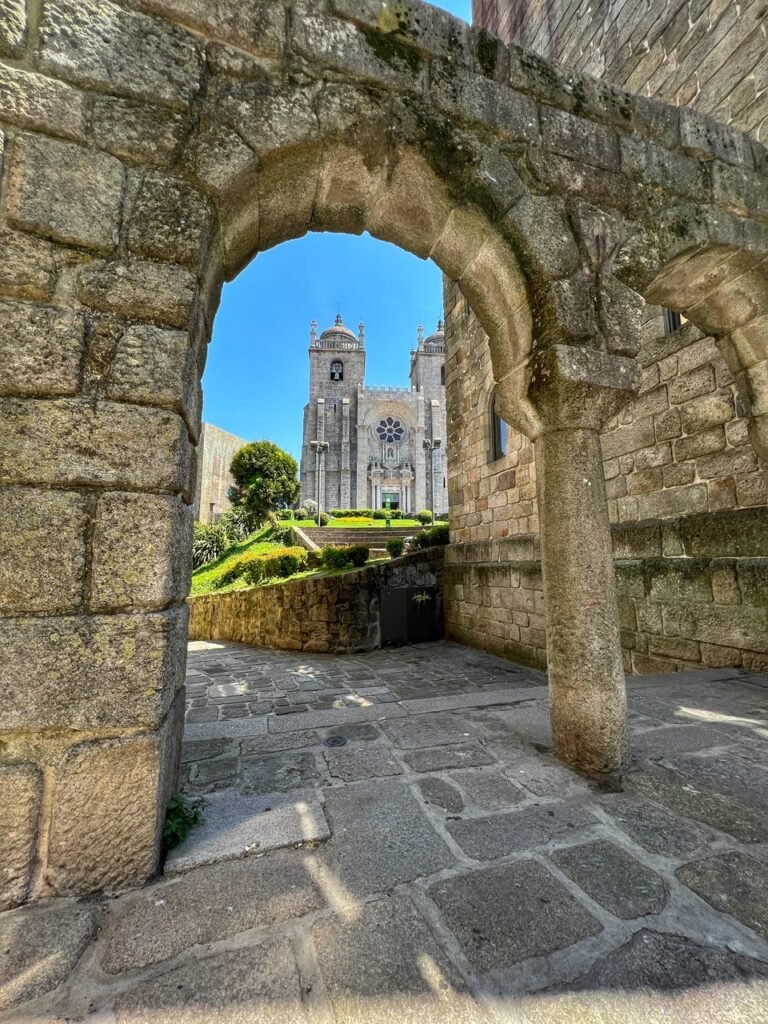
A peep of the Porto Cathedral
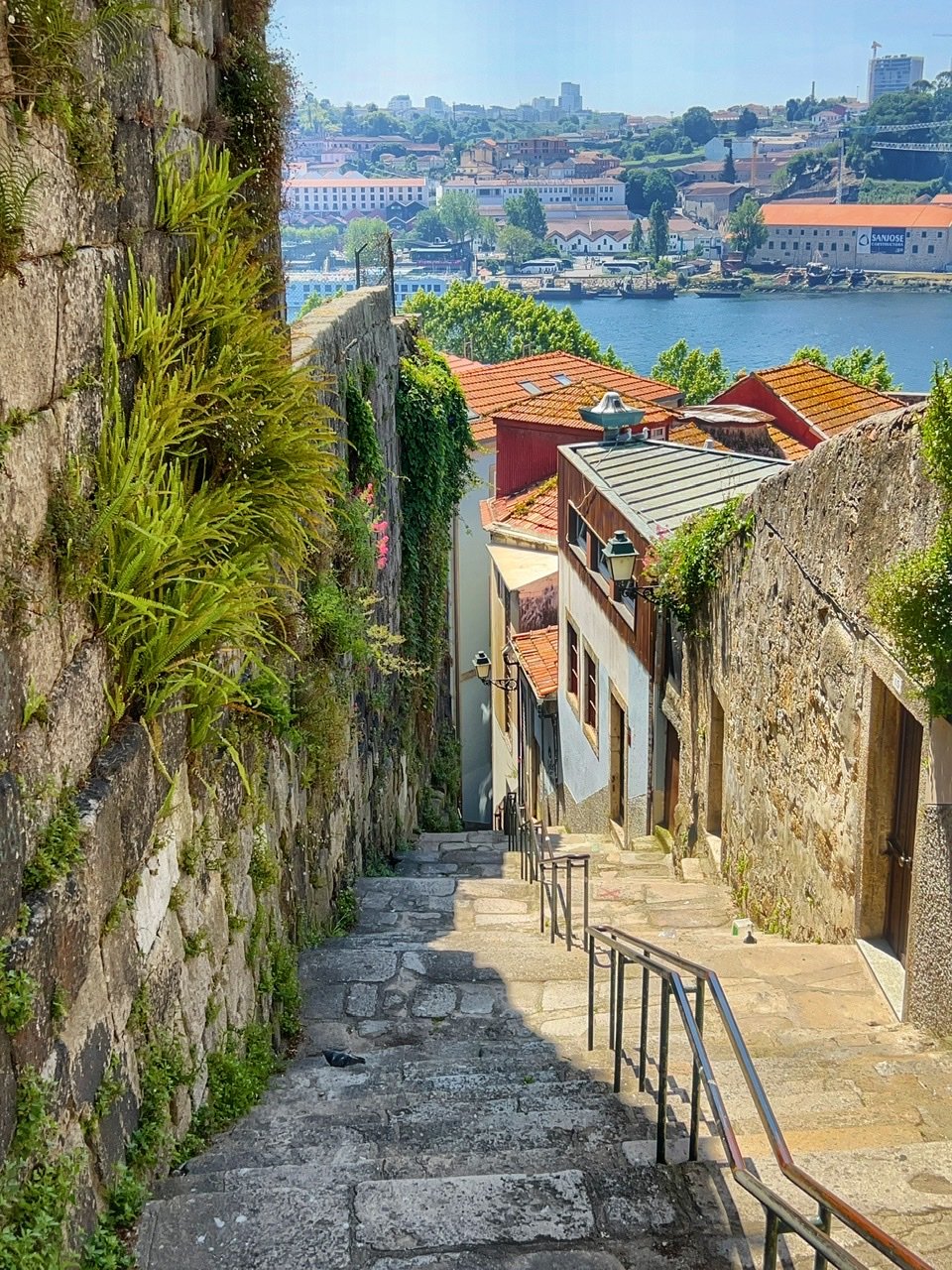
Why it was endowed with its riverside namesake. Unbelievably picturesque!
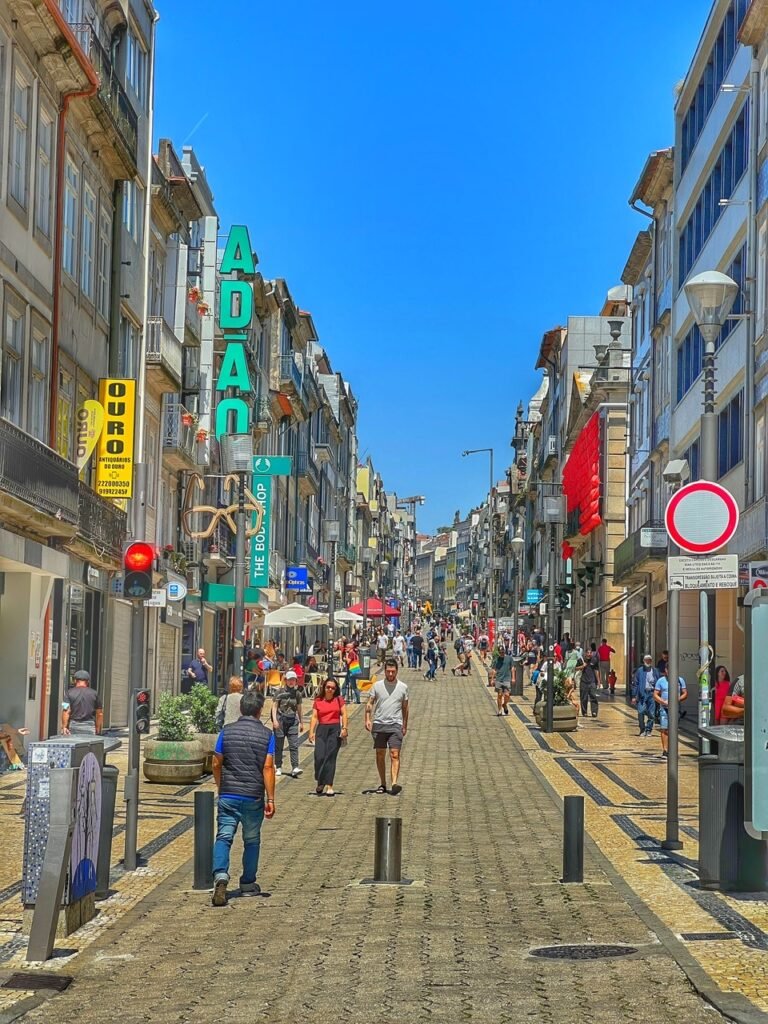
One of the many pedestrian drags in the city. When you can walk, it’s definitely a walker’s paradise!
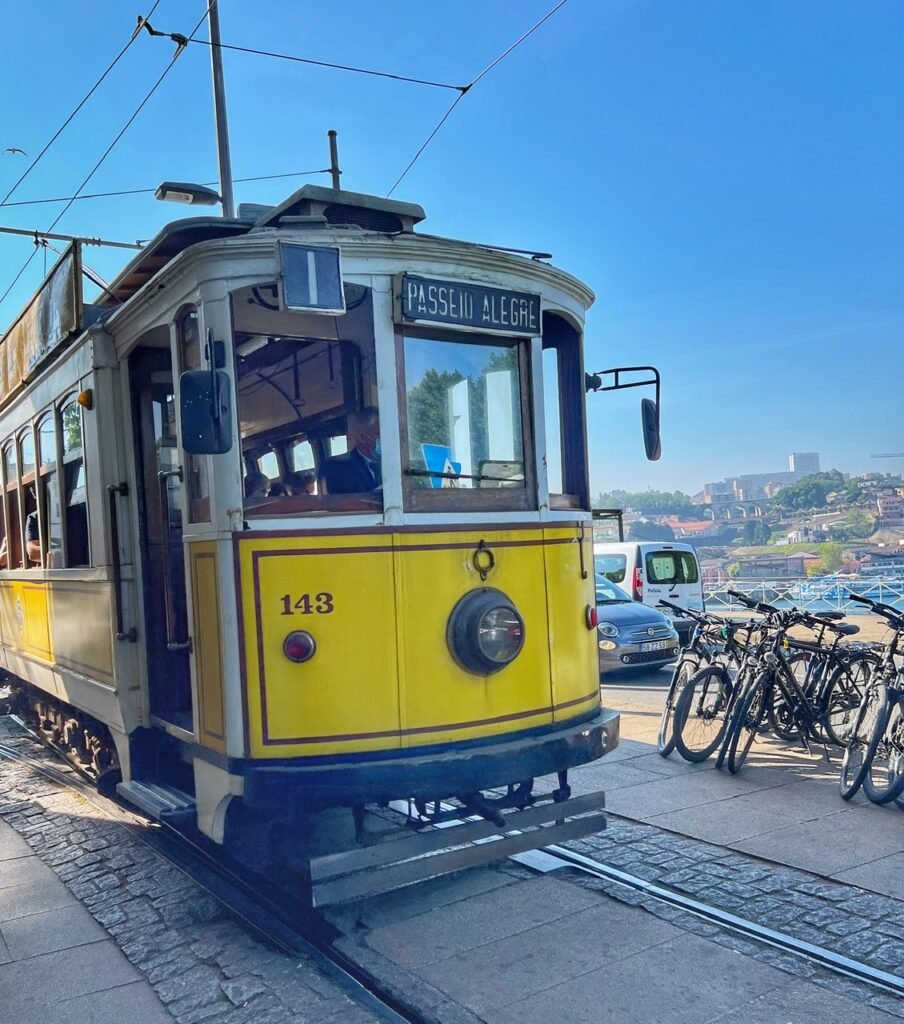
The historic tram of Porto. It is one of the oldest electrified transport systems in Europe, as it was inaugurated in 1895. It’s pretty much only used by tourists now because locals use the more efficient buses and light rail system. This reflects in the price as one ride cost 3.50€. Wow, that’s a steep spin on the trolley, in more ways than one.
Azulejos
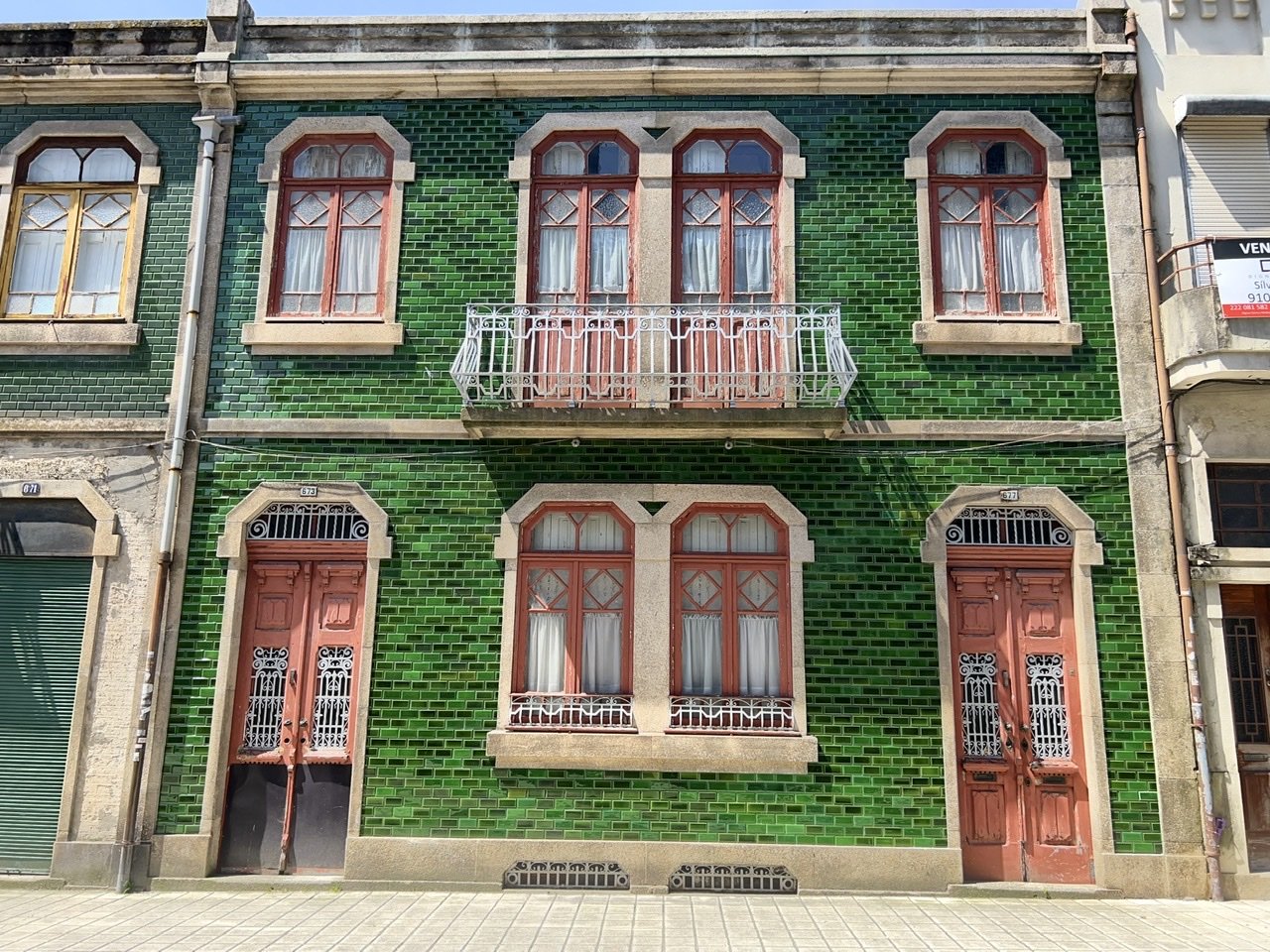
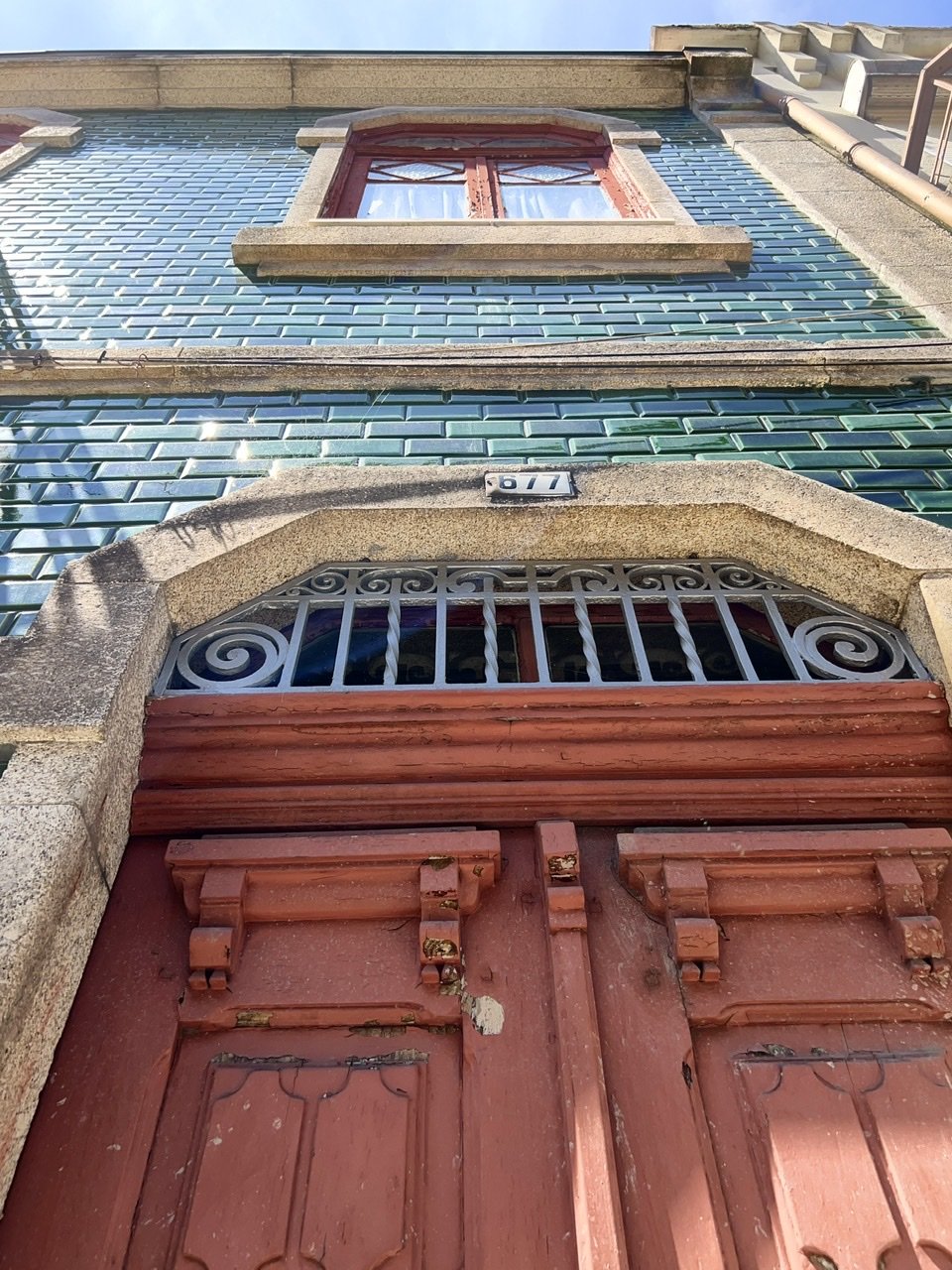
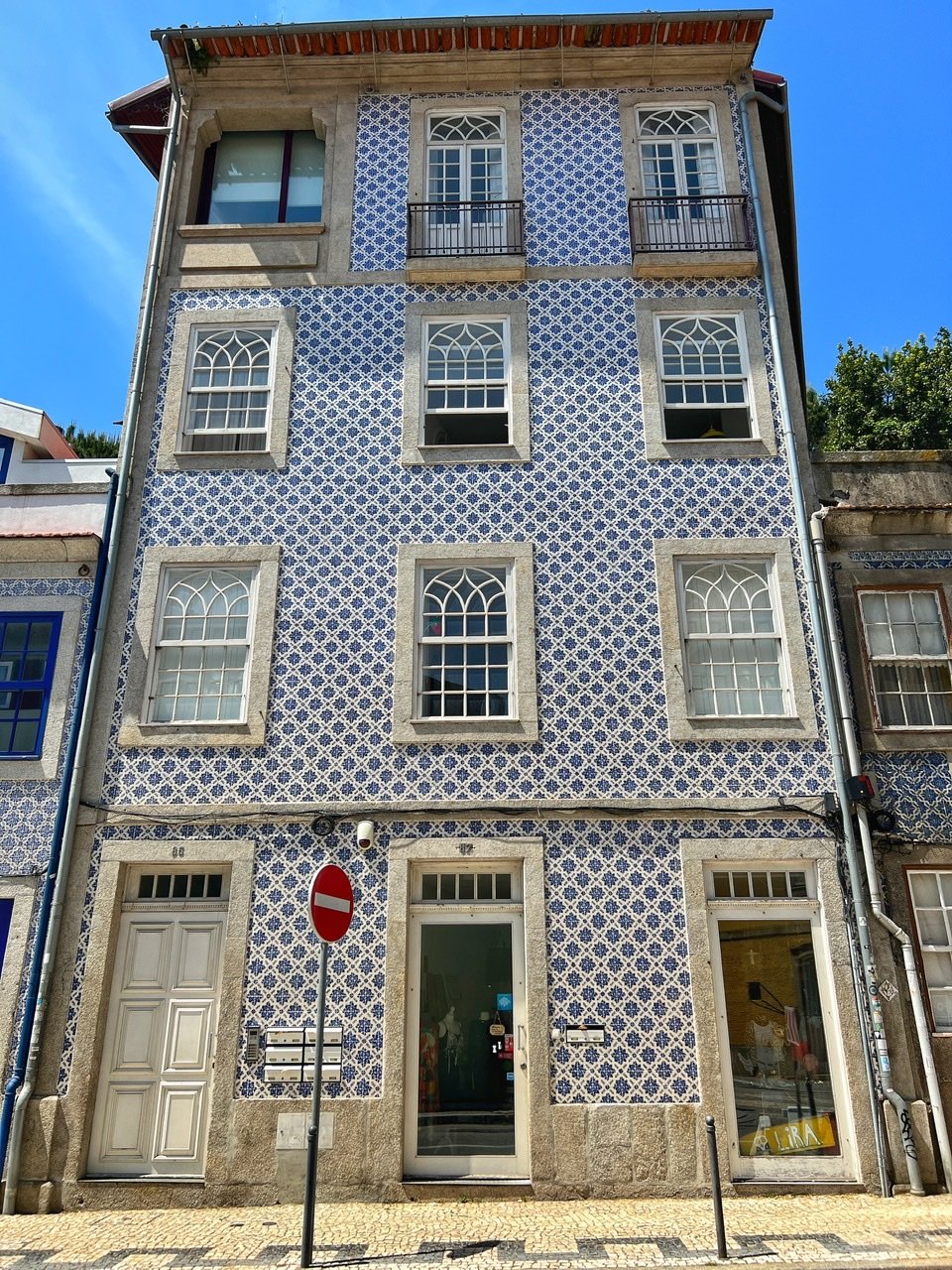
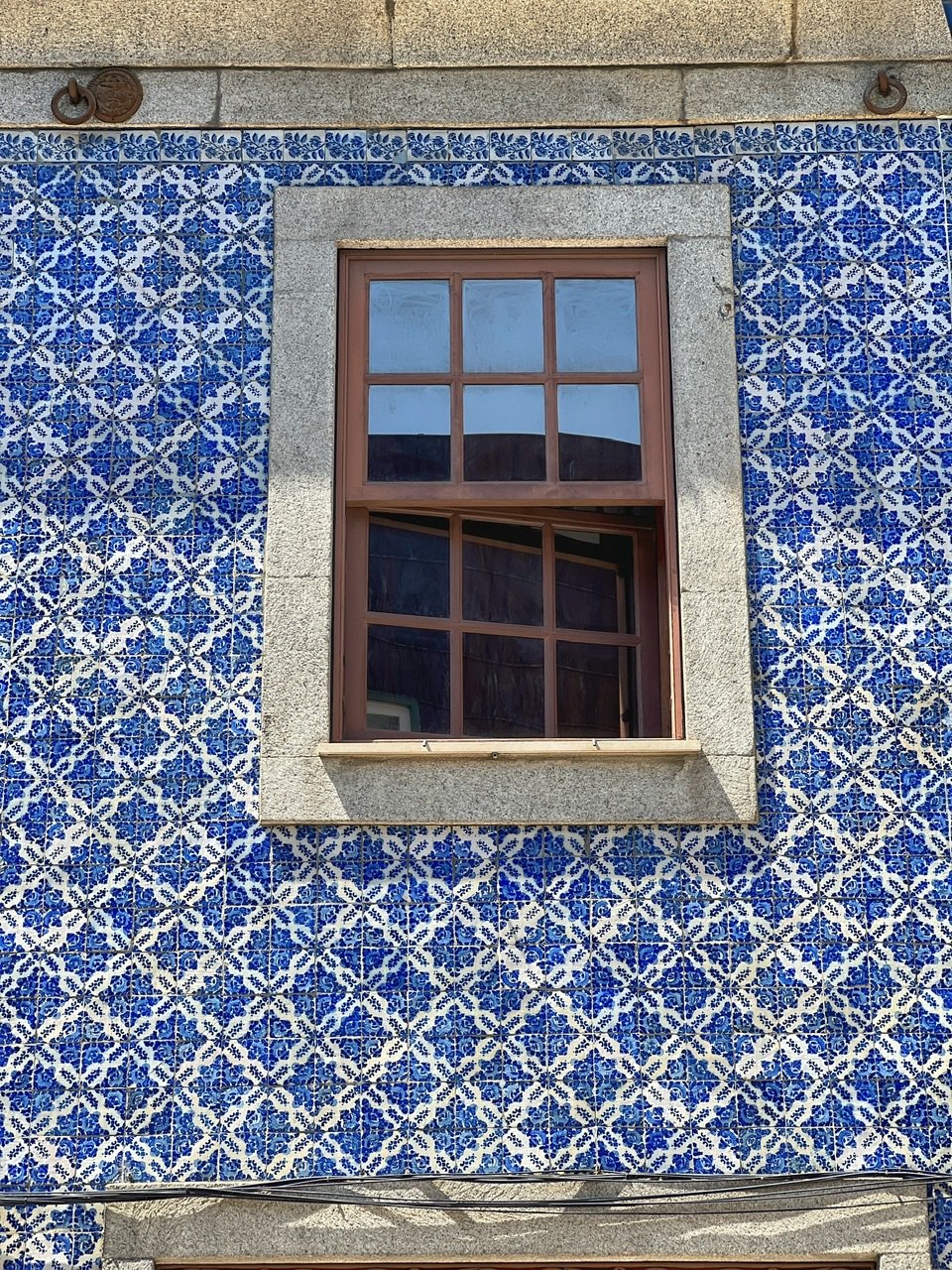
Azuelejos are colorful tiles used in building facades that date as far back as the 13th Century, when the Moors invaded the land that now belongs to Spain and Portugal. It wasn’t until Portugal’s King Manuel visited Seville and brought this idea back, that Portugal truly adopted this artwork into its culture. Above is a small sample in some of the residences and businesses of the city.
Port Wine Tasting Tour

When in Porto…you partake in Port(o). So, for Greg’s birthday we decided to splurge (with our free Delta Airlines fun money) on a nearly private Airbnb experience tour with C&D Porto Local Tours for $43/each. It took us to three lesser known tasting rooms not slammed with tourists on the Villa de Gaia side of Porto. This ended up being an exceptional, yet slightly intoxicating decision of this 20% boozy delight. By the way, we learned from our guide that the average Portuguese adult drinks FOUR liters of wine per WEEK!! (port among others!) They are the biggest wine drinkers in the world.
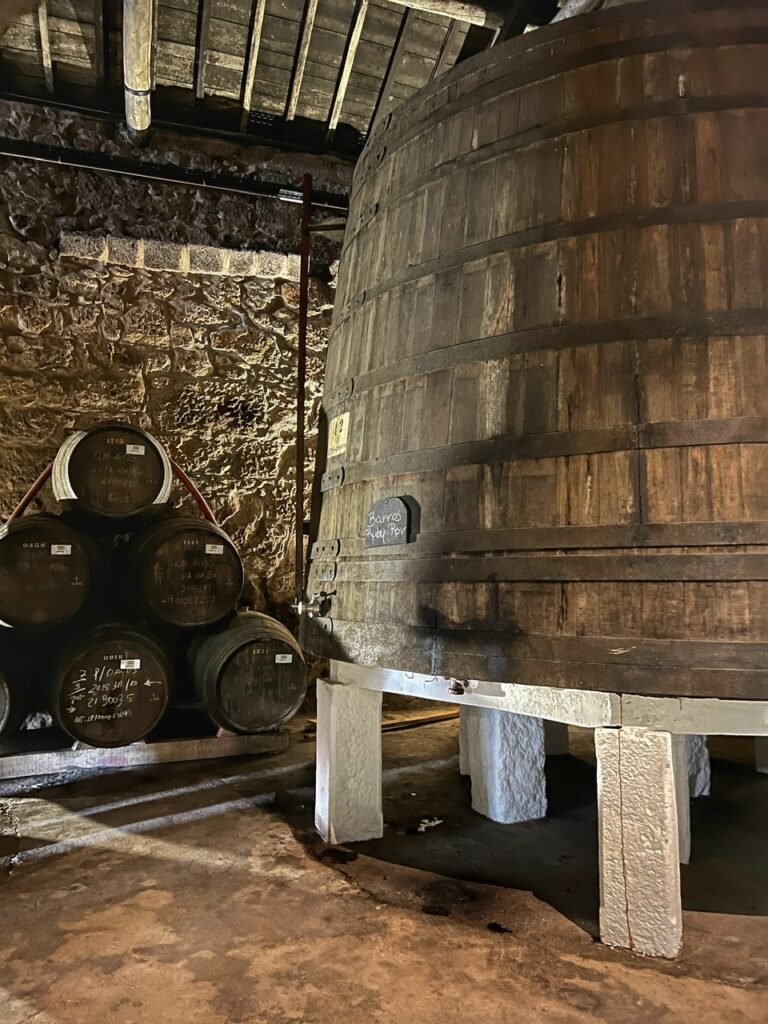
We started at Sogevinus Wine Shop where we learned more about the process. Port(o) wine is Portuguese fortified wine only produced in the Douro Valley of Portugal, which is the oldest wine region in the world dating from 1756. (In this way, it’s much like Champagne from that region of France or Tequila from Mexico.) The barrels used can be hundreds of years old which keep getting repaired. As you can imagine, barrel repair men are getting harder and harder to find so they might inevitably be phased out entirely.
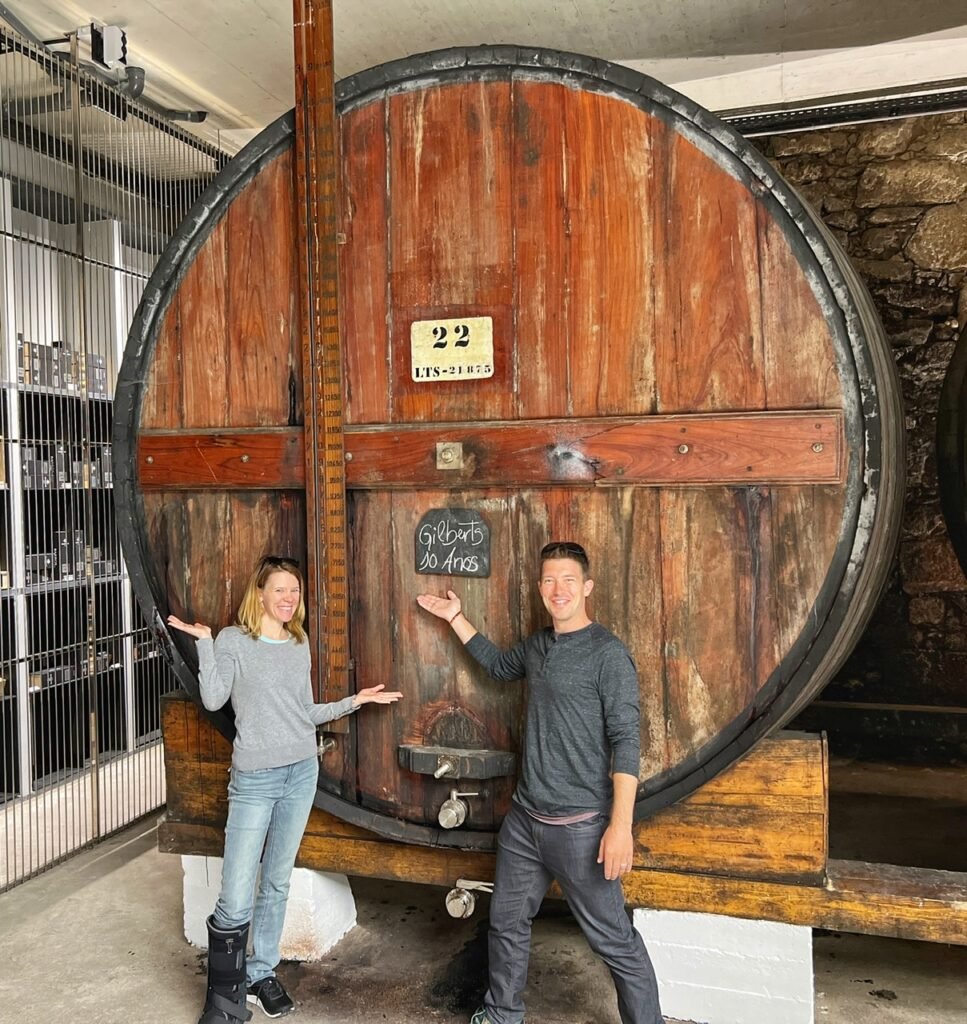
Welcome to Wine World! Port wine is typically richer, sweeter, heavier, and higher in alcohol content than unfortified wines. This is caused by the addition of distilled grape spirits (brandy) to fortify the wine and halt fermentation before all the sugar is converted to alcohol.
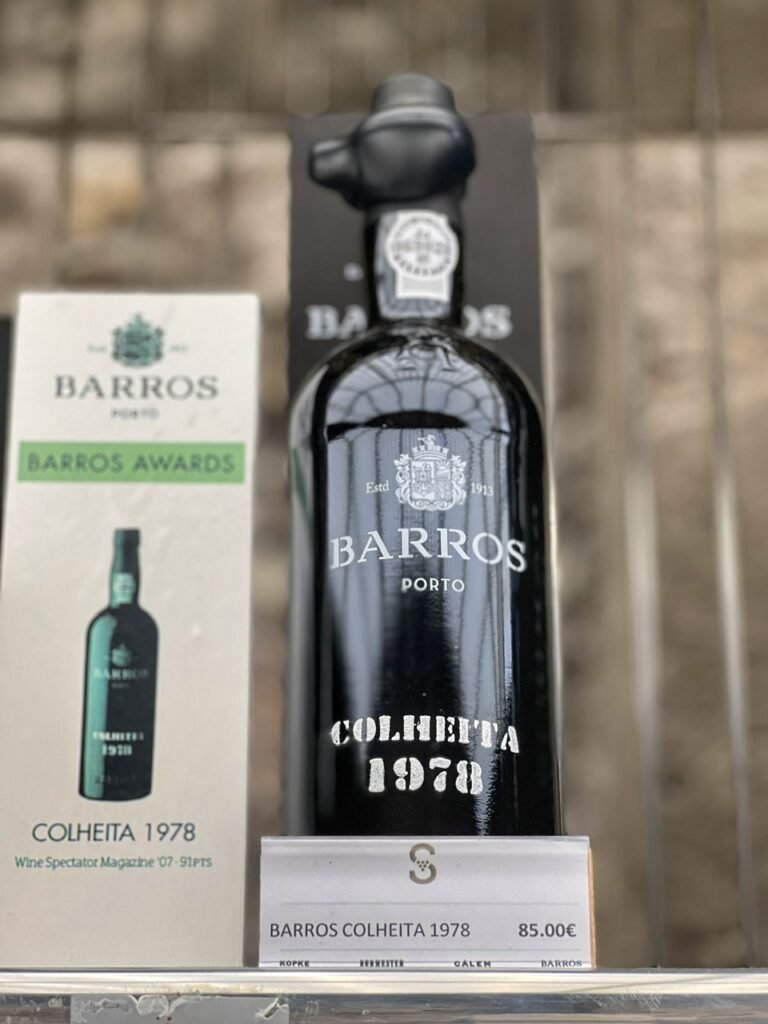
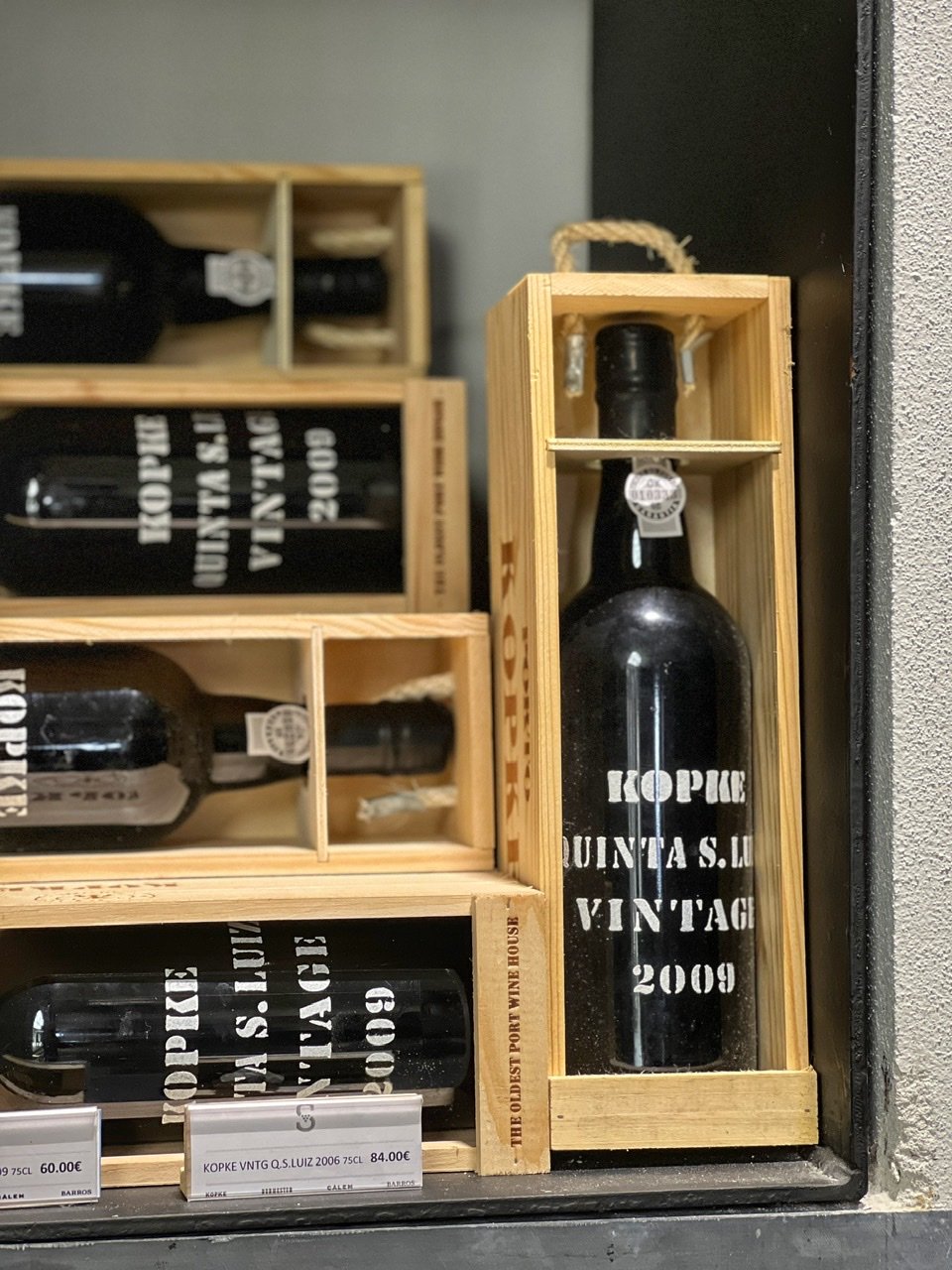
This bottle at left is aged 44 years…just like Greg. We briefly contemplated buying it until we spied the 85€ price tag ?
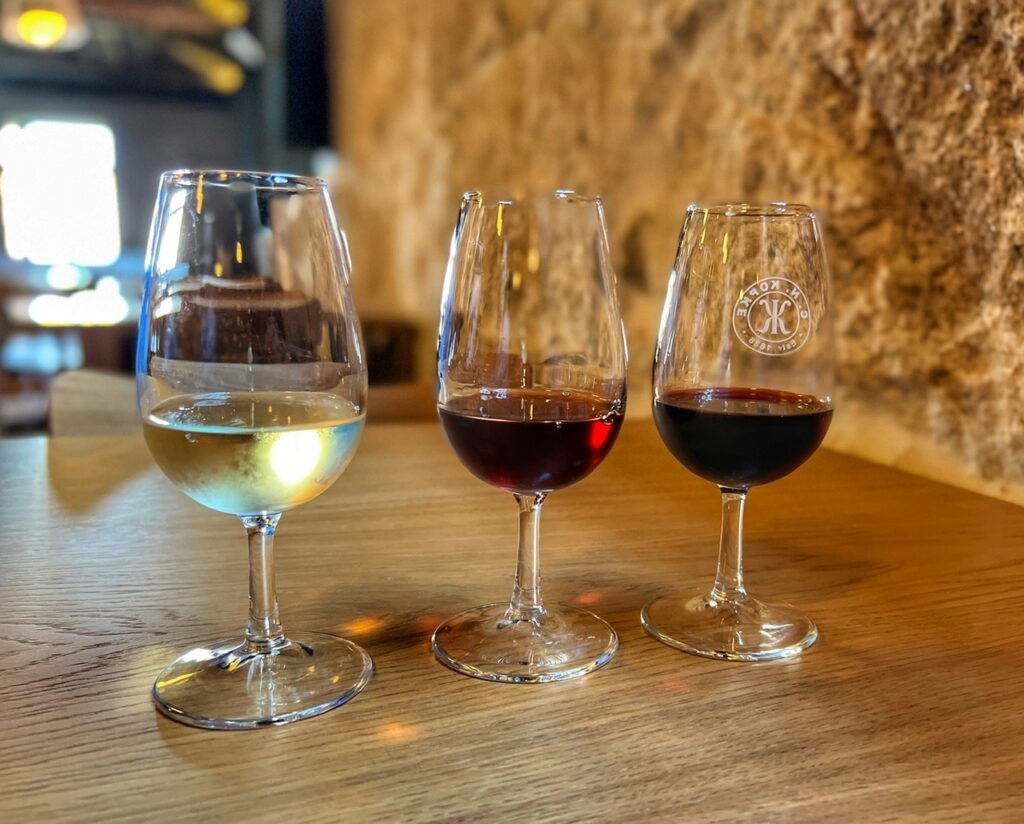
Port(o)s has three main varieties: white, tawny or ruby. They are typically drunk for different occasions and weather, and very rarely used to accompany dinner.
- White is frequently used for summer and sun and is typically fruity or floral. This one was on the drier side and we really liked it!
- Tawnys are aged in wood, brownish in color and often have nutty or caramel notes. Our guide said for him, “it tastes like Christmas” and we had to agree. Apparently it also goes well with cigars, but we didn’t test that theory. Without the cigar, however, it was bold, sweet and full-bodied and we loved this one most.
- Rubys, of course, are red and also aged in wood but for a short time. They are the most popular and cheapest and pair really well with desserts, especially chocolate.
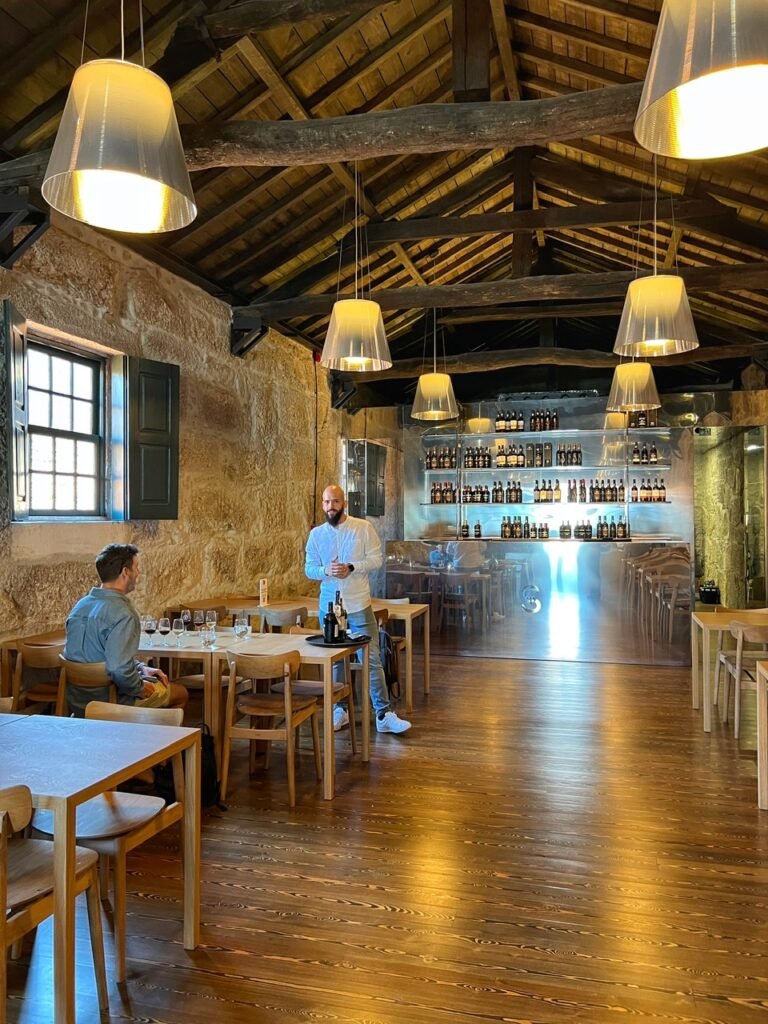
The tasting room and our guide, Jose. By the way, the “J” is pronounced in Portuguese the same as it is in English.
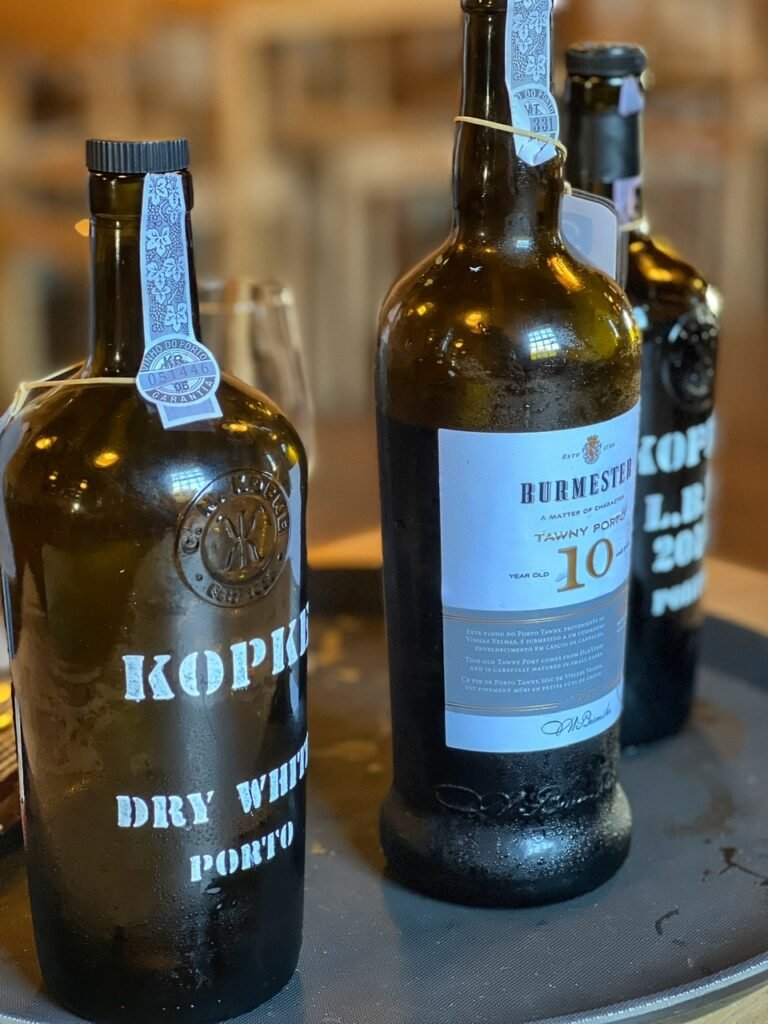
The three bottles of Port(o) we tried. You might notice I keep writing Port(o) as so. This is because, Port is not the real name. It’s only true “port” wine if it is labeled as Port-O. If you buy Port wine anywhere else, it’s a knock off. Also, you might notice, it’s all in English. This is because the majority of Portos are exported to the UK and have been since the 1850s. At that time, winemakers discovered that the custom of fortifying wine by adding brandy resulted in a stronger, sweet flavor that was a hit with British customers, and Port wine as we know it today, was born.
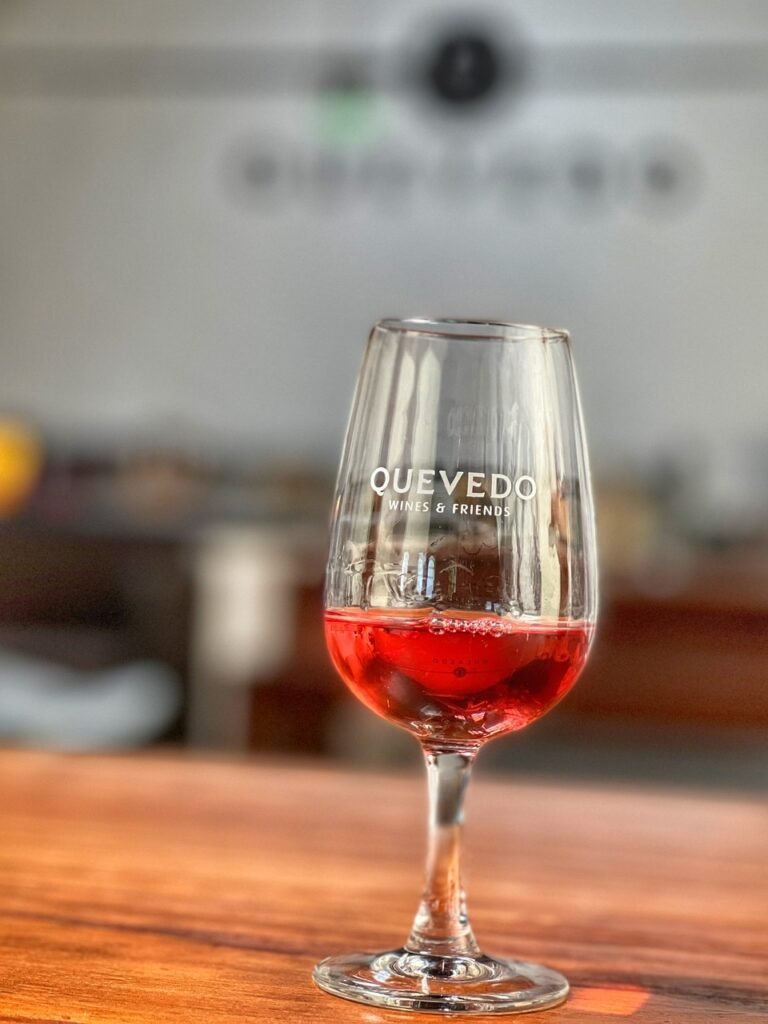
Our next stop was Quevado Winery where we got to sample a Rosé port. Rosé Port only became a “thing” in 2005 because traditional Porto wine producers would not accept it as authentic. Guess when they saw the potential to increase their bottom line, they changed their minds. Because it’s a BIG thing now. It was refreshingly quaffable! Here we also got to listen to live Fado music which was melancholy and soulful. Very beautiful.
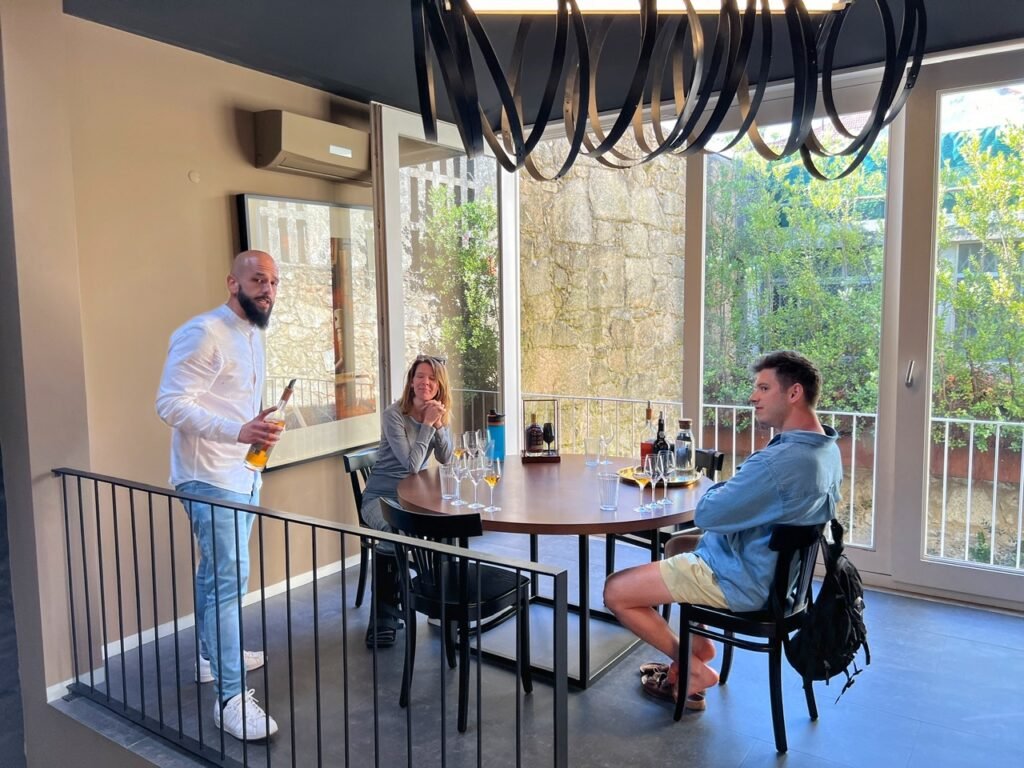
Putting our game faces on for another round. There was only one other guy, Jared the Canadian, on the tour. We loved the intimacy and the attention we got.
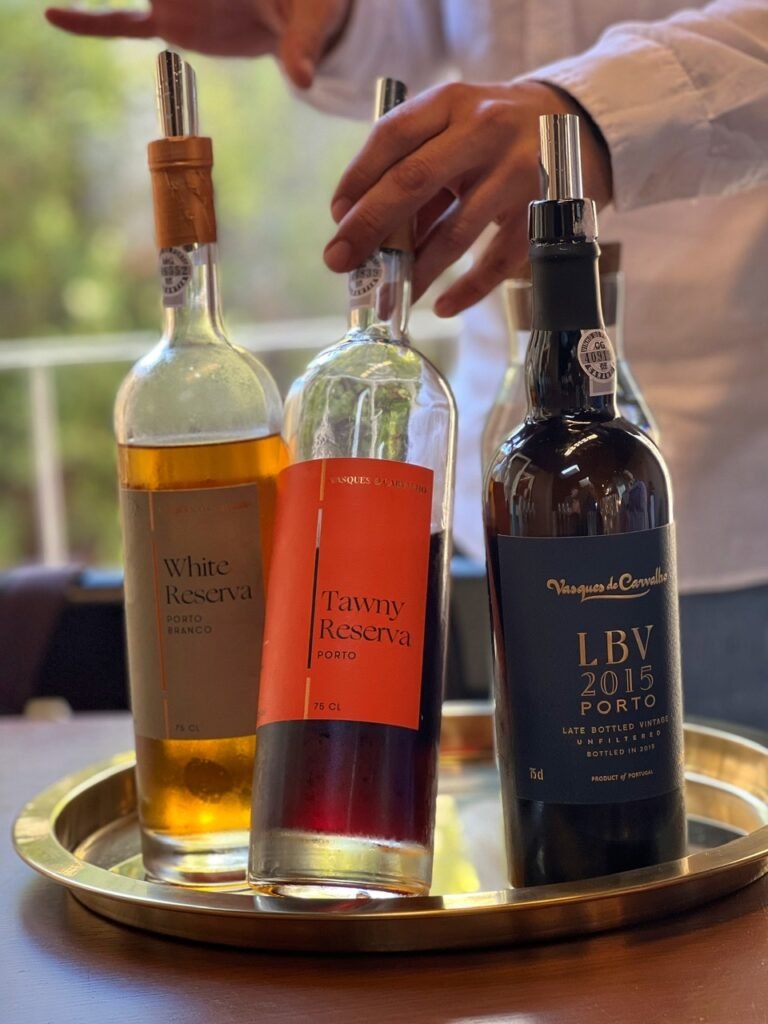
The next three (or more? ?) pours at Vasques de Carvalho winery were also a white, a tawny and a ruby.
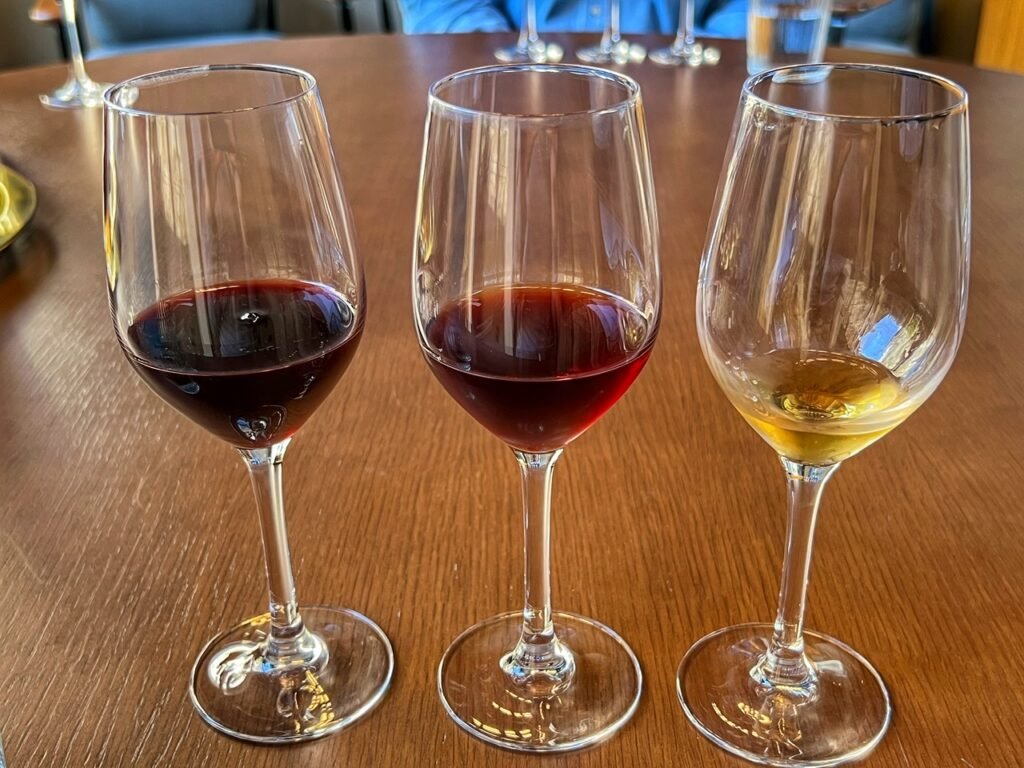
What a day! If you’ve never had real port wine, do yourself a favor…it’s divine!
ChatNoir Maison: Our Accommodation

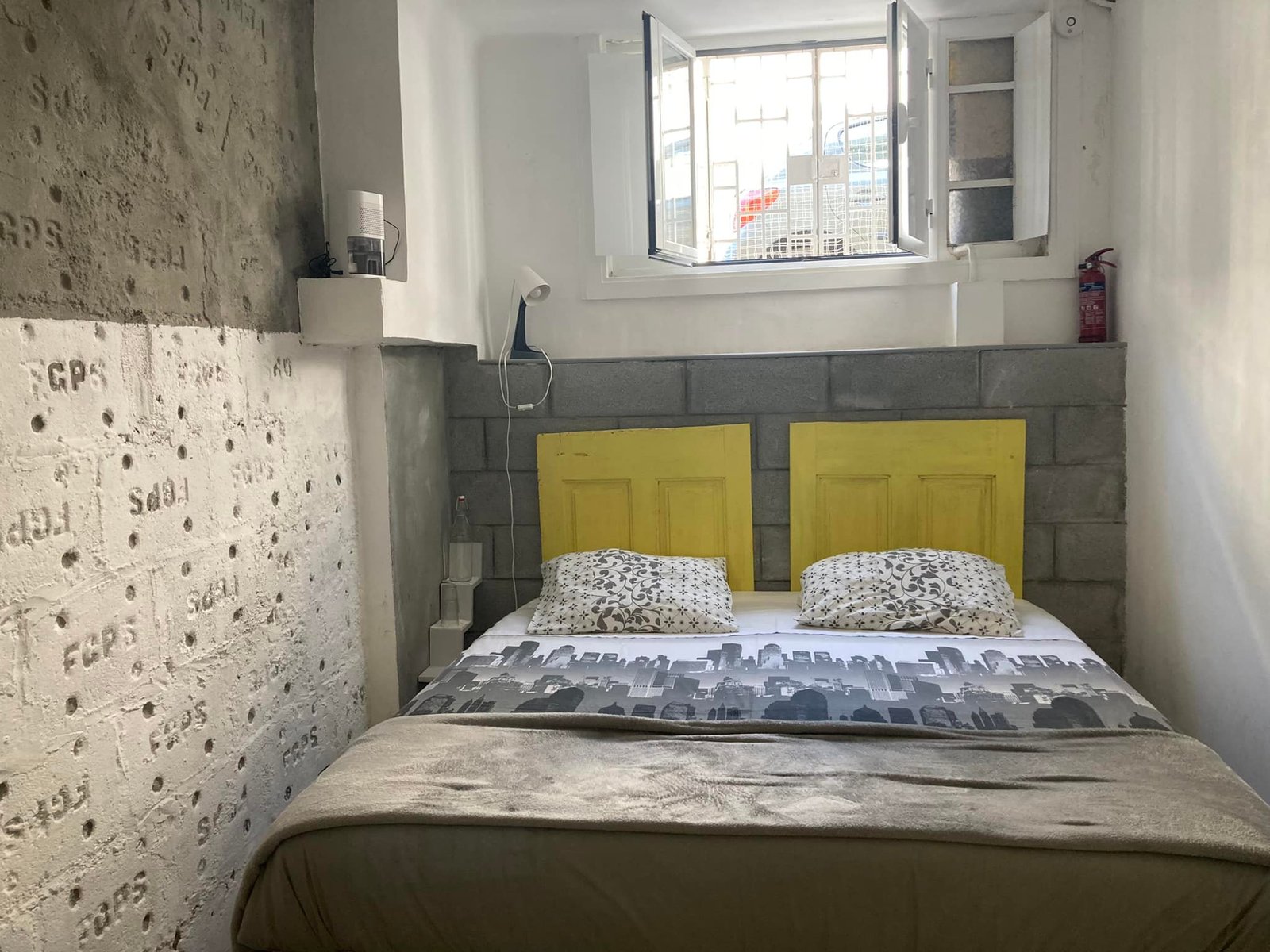
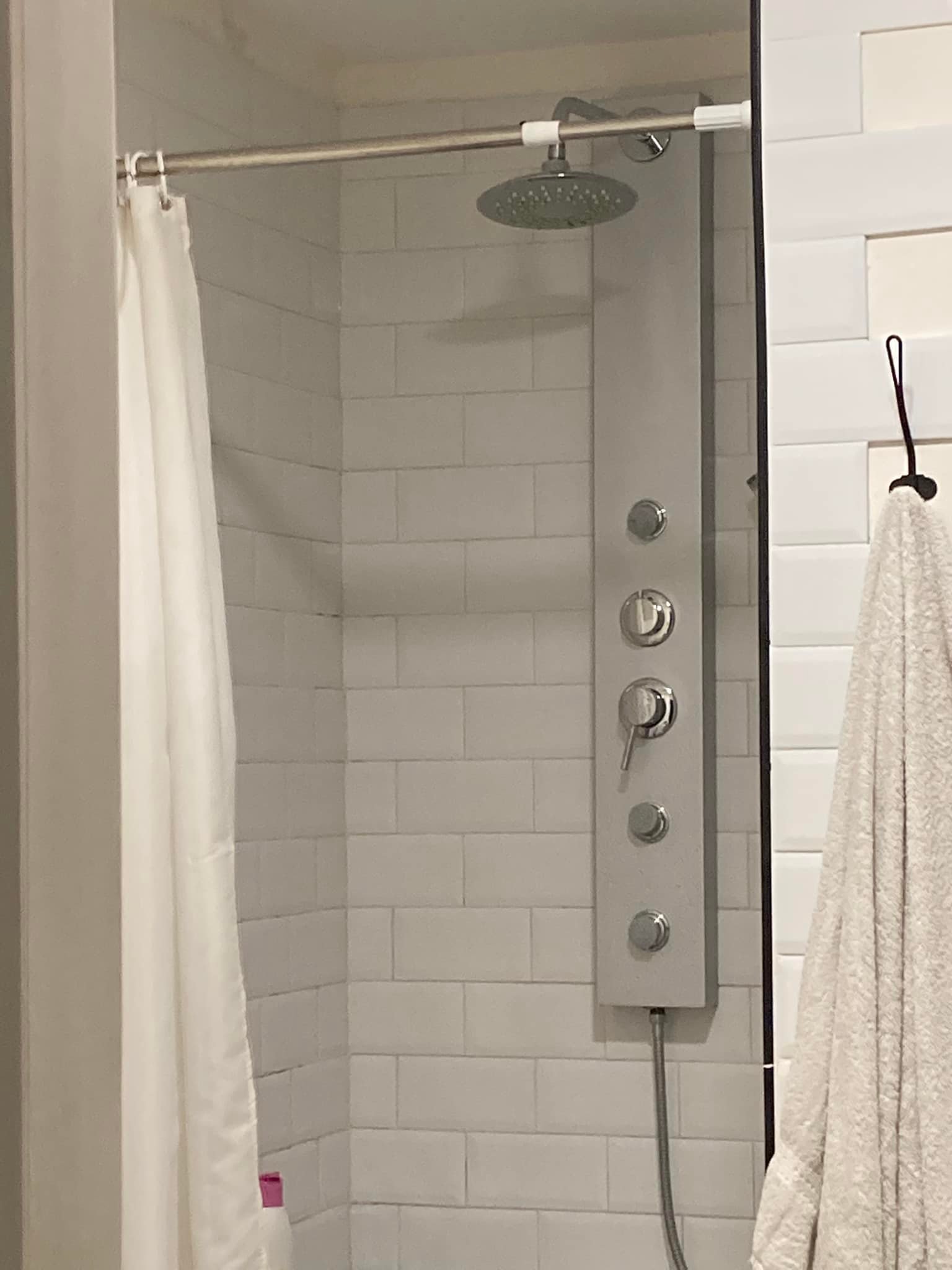
We stayed at the ChatNoir Maison, curiously named in French, not Portuguese, due to its star residents. Since we’re back in Cat-Land, you can expect us to gravitate to anything including four paws and a meow. The accommodation was a good 20 minute walk to the center of Porto. When we originally booked, this was not an issue because Mandy was still walking, but Greg was able to get to groceries and move around for the things we needed. It cost $26/night which included a private room and bath, with a very fancy shower. A shower that would become a very fun disaster for Mandy when she arrived without Greg’s assistance a day before.
Since we hung out quite a bit at “home,” due to the foot thing and jet lag, one of the great things we finally got to try out while in Porto was the app called “Too Good to Go.” We discovered it back in Colombia, but unfortunately it hadn’t migrated to South America yet. So, finally in Europe, we were very eager to give it a go. This (mostly) global app available in select cities that hooks up people with restaurants and grocery stores with heavily discounted food at the end of the day that would otherwise be thrown away. It’s a win-win for the customer, the business and Mother Earth! We only hope this catches on everywhere! We even received a BOX of table wine with our 2.99 € order in addition to lots of other goodies![]()


The food at left was all 4.99 € ($5.26) originally 15€ from a catering company. It included spinach soup, a fish casserole type dish and rice with lima beans and pork. At right, the grocery visit was an even bigger value at 2.99€. In addition to the box of wine (yes, the container was damaged but the wine sealed and fresh), we received: 10 bread rolls, 10 apples, 3 turnips, cabbage, 4 sweet potatoes and 4 regular potatoes.
Medical Tourism: A Visit to the Orthopedic Foot Doctor
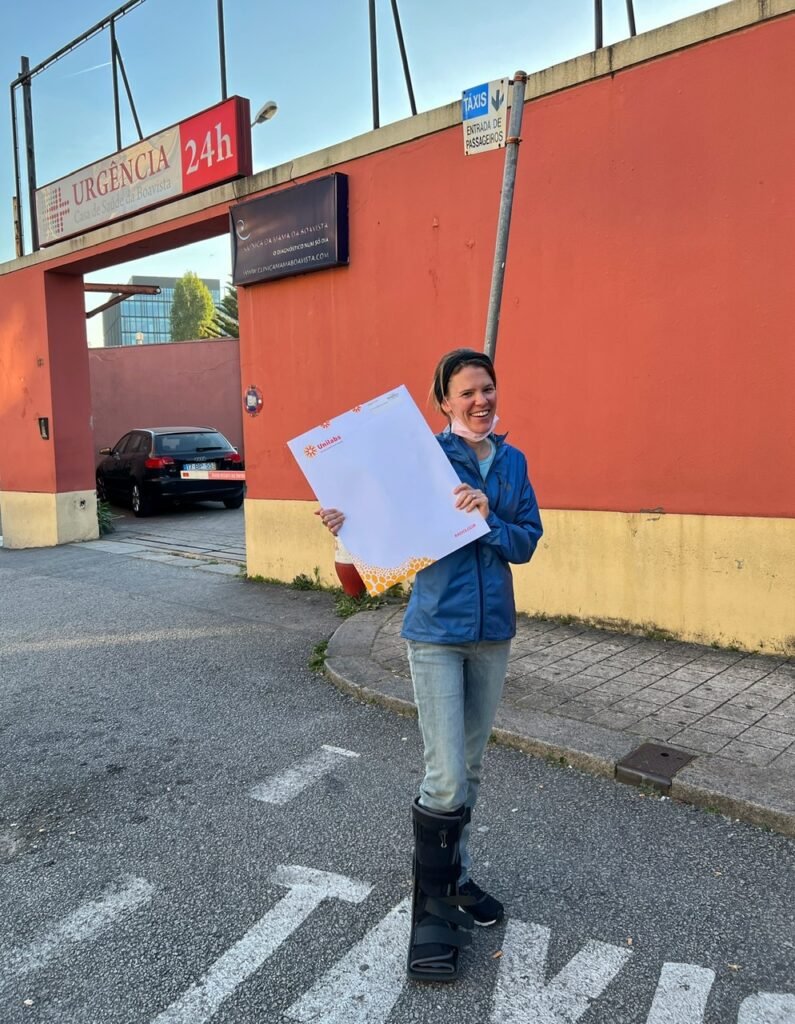
There was no question that Mandy would be seeking medical help while in Porto. Below, Mandy she shares her experience at Casa do Saude da Boavista
“I have received the results of my MRI. I received this MRI (cost 250€ or $261) immediately upon asking here in Portugal, although it took a long nine days to get the results. I also got to take the giant folder of scans (perfect for backpacking!) with me when I left the lab. The initial consultation was scheduled the same day I contacted them and cost 75€.
The doctor, whom I’ve been wonderfully emailing directly with daily, says I have a “retrocalcaneal bursitis”, which is a inflammatory condition of the heel pad/cushion. He is telling me to ice it 3 times a day (which I’ve been doing) and massage with a specific cream daily. He said to bag the stability boot which I never should have been given. In fact, it definitely made things worse. If the doctors in the States had given me an MRI right away, maybe I could have avoided this. The steroids I was given also masked the pain of how I was actually feeling leading to multiple setbacks. The doctor here said to switch to slippers. He also said to stop immobilizing it with crutches. My first thought was, “But… i can’t walk without nerve pain!!”
And then I reflect and remember, two nights ago, before I got this result, I did a long meditation and stood for the first time without pain. On the same night, it led to walking using my crutches as stabilizers without pain. I was repeating the mantra to myself, “don’t be afraid” with every step and breathing deeply.So what is this experience trying to teach me? Sometimes you manufacture pain. And sometimes it is real. This has been a doozy for me to understand because all the chronic pain I’ve ever known has been connected to emotions.
The MRI confirmed I do have heel pain for a physical reason, which can be fixed with some patience (another lesson). But the nerve pain, as it has been many times before, is in my head. I fear every step I take, and therefore there is pain. As soon as I started walking and meditating saying that mantra which I did again for 30 minutes this morning, I’m beginning to trust there there actually is no nerve pain.
So all that said, I’m making progress.”


